
How To Heat A Sailboat

Last Updated by
Daniel Wade
June 15, 2022
If you want to extend your boating season into the winter season, stay toasty warm, and dispel the dampness that can infiltrate your boat in cold weather, you need to get a reliable boat cabin heater.
Winter sailing is always a real challenge for most sailors given that the weather conditions are more adverse and calls for more preparedness. Fortunately, several types of boat cabin heaters can transform winter sailing into a more pleasant experience by keeping the interior of the sailboat warm and cozy. So if you do not want winter to spell the end of your sailing season, you’ve come to the right place: here’s how to heat a sailboat.
As we’ve noted, there are several ways to warm your cabin during the winter season or on a cold night. From hydronic systems, heating stoves, engine heaters, forced-air systems to reverse-cycle air condition systems and electric heaters, there are a lot of options for every budget. Although these systems may work differently, the basic idea is the same. They all either use fuel or another energy system to create heat that’s spread throughout the boat.
Let’s explore the most common ways to keep your sailboat warm during the cold season. But before going into that, let’s highlight some critical details.
Table of contents

How to Choose an Appropriate Boat Cabin Heater
The thermal outputs of these heating systems are generally measured in British Thermal Units (BTUs). The more BTUs a system produces, the warmer it can make your boat cabin. You should, however, remember that more BTUs will increase your electrical or fuel demands. In addition to BTUs, choosing the right heating system for your boat will depend largely on how well your boat is insulated, the kind of boat you have, how much time you spend sailing in cold weather, where you’re planning to sail the boat, and how much you’re willing to spend.
A Word of Warning
The dangers of poorly installing a heating system on your boat can never be underrated. Keep in mind that most of these systems will keep your cabin warm by burning oxygen, which can potentially fill the cabin with the deadly carbon monoxide that can quickly leave victims unconscious and may lead to death. As such, safety should be a priority.
How to Heat a Sailboat
Hydronic systems.
These systems are based on the same principles as household hot water heating systems. It revolves around a heated fluid running through a tube to radiators or fan units that warm the air. These tubes should run throughout the sailboat but the fan units or radiators can be divided based on the number of zones that the boat has.
In most cases, a hydronic system is smaller than a water heater but can also be used as a portable water heater for the boat, especially if you need hot water onboard. It’s generally installed in the boat’s engine room and can use a coolant to disperse the heat. It can use the fuel coming from the vessel’s main fuel tank or a special fuel tank.
The main advantage of using a hydronic system is that there is no moisture in the boat as there are no cold spots. An appropriate hydronic system should have a maximum output of 25,000 BTUs per hour while using 6 amps of power or 0.22 gallons of fuel.
Heating Stoves
Although they’ve been used for centuries, heating stoves remain one of the most popular ways to heat a sailboat. They can burn kerosene, diesel, and propane or even use solid fuels such as charcoal or wood. Some heating stove systems use the direct draft system whereby fresh air is pumped through a fan while others use the natural draft system whereby air is naturally pumped through the combustion process.
Either way, a heating stove should be located in the saloon to radiate heat and circulate hot air. They should be equipped with a damper to help in controlling the airflow, as well as an exhaust pipe to withdraw the exhaust gases arising from the combustion.
Keep in mind that most heating stoves do not use electricity. Nonetheless, a heating stove with an output ranging between 7,000 and 9,700 BTUs should be ideal, especially if it consumes about one pound of propane in about 5.5 hours.
Engine Heat
This revolves around using the engine’s heated coolant fluid to transfer the warmth into your boat’s cabin. The coolant lines should be designed to run from the engine into the heat exchanger. There should also be a fan that blows the cabin air into the heat exchanger so that the air is heated. The hot air can then be piped out into the boat’s interior through several hoses.
Using this system is advantageous in the sense that it’s quiet and depends on the engine’s closed-circuit cooling system, so it doesn’t require radiators or additional water pipes. Unfortunately, this system only works when the engine is running and can be quite expensive in terms of the extra engine maintenance and the fuel consumed.
Forced-Air Systems
This is a simple method that revolves around a heater burning fuel to heat air. This hot air is then forced through ducts via a series of vents to the boat’s cabin. Forced-air heaters are typically situated in engine rooms and generally have exhaust pipes to discharge combusted fuel.
The system can be turned on either manually or through its thermostat so that air and fuel are drawn into the combustion chamber to ignite the fuel and air blend under a controlled flame. This heated air is then forced into the duct and spread throughout the boat’s cabin.
Electric Heaters
This can be a perfect option if you occasionally go out on the water during cold days. Electric heaters function much like normal home ACs and usually run on 12-volt power. They’re typically mounted inside the cabin and run on electricity generated from the boat’s batteries that heat the coils. A fan draws air over the coils where it’s heated before another fan blows it into the boat’s interior.
The main downside of this system is that it has to use electricity, which means that you cannot venture very far from the shores. This is because you’ll need to recharge the batteries now and then and this will run them down very quickly.
Reverse-Cycle Air-Conditioning Systems
This works in the same way as a normal household heat pump by running in the reverse cycle. They’re typically very expensive but can be a great way to extend your sailing in the winter, especially if you want to circumnavigate the globe.
Another good option of heating your sailboat is heading south to sunny places such as Florida during winter. In most cases, the south is a bit warmer than the north during winter and you can keep going until you find the hotter climes of the south.
Installing a heating system is a great way of making the cold nights and winter season more pleasant and attractive. There are, of course, several ways to ensure that your boat is heated and warm, especially if you do not want to put the boat into storage and get back to the normal life on dry land just because it’s winter!
So if you still want to make winter a perfect sailing season , keep your cabin cozy with the above-described heating systems.
Related Articles
I've personally had thousands of questions about sailing and sailboats over the years. As I learn and experience sailing, and the community, I share the answers that work and make sense to me, here on Life of Sailing.
by this author
Sailboat Upgrades
Most Recent

What Does "Sailing By The Lee" Mean?
October 3, 2023

The Best Sailing Schools And Programs: Reviews & Ratings
September 26, 2023
Important Legal Info
Lifeofsailing.com is a participant in the Amazon Services LLC Associates Program, an affiliate advertising program designed to provide a means for sites to earn advertising fees by advertising and linking to Amazon. This site also participates in other affiliate programs and is compensated for referring traffic and business to these companies.
Similar Posts

How To Choose The Right Sailing Instructor
August 16, 2023

Cost To Sail Around The World
May 16, 2023

Small Sailboat Sizes: A Complete Guide
October 30, 2022
Popular Posts

Best Liveaboard Catamaran Sailboats
December 28, 2023

Can a Novice Sail Around the World?
Elizabeth O'Malley

4 Best Electric Outboard Motors

How Long Did It Take The Vikings To Sail To England?

10 Best Sailboat Brands (And Why)
December 20, 2023

7 Best Places To Liveaboard A Sailboat
Get the best sailing content.
Top Rated Posts
Lifeofsailing.com is a participant in the Amazon Services LLC Associates Program, an affiliate advertising program designed to provide a means for sites to earn advertising fees by advertising and linking to Amazon. This site also participates in other affiliate programs and is compensated for referring traffic and business to these companies. (866) 342-SAIL
© 2024 Life of Sailing Email: [email protected] Address: 11816 Inwood Rd #3024 Dallas, TX 75244 Disclaimer Privacy Policy
Yachting Monthly
- Digital edition

How to install hot water onboard a yacht
- Toby Heppell
- May 5, 2023
Having hot water on board can make a long cruise a whole lot more pleasant. Duncan Kent explains how to install hot water onboard a yacht

Having pressurised hot water on your boat will make all the difference to comfortable living when on board. A hot shower at the start of the day can invigorate the crew for the day ahead, and washing dishes and clothes without boiling a kettle is so much easier.
To enjoy the luxury of hot water on your boat you will need both a pressurised freshwater system and a calorifier. Most modern production yachts come with at least a basic cold water system, incorporating a pump that activates by the drop in pressure when a tap is turned on. If yours doesn’t, then it’s a fairly simple and inexpensive modification to carry out. The hot water system then utilises the same pump and water supply, but is piped through a calorifier on its way to the hot tap.
The Calorifier
A calorifier is a heavily insulated copper or stainless steel water tank with an electric heating element, not unlike a domestic hot water tank. Copper tanks are marginally better than steel at retaining the heat and have excellent antibacterial properties.
The difference between a marine calorifier and a domestic tank is that it also contains a spiral copper tube through which water from the engine’s freshwater coolant pump is circulated. Some twin-coil calorifiers are also available for those who want to circulate hot water from both the propulsion engine and a diesel-fuelled, hot water heating system.

Hot and cold domestic water system, with a pump, calorifier, expansion tank, accumulator tank and multiple outlets
Electrical power
For running off electricity, a calorifier can either have a 220Vac element inside, for use when you’re on mains shore power, or a 12Vdc element to run off your domestic batteries. The latter will be much lower power (typically 300W), however, and will take a good deal longer to heat the water, but they are a great idea if you have excess solar power to use up during the summer months.
Some calorifiers use an inverter (DC to AC converter) to power the 220Vac element, but this merely adds increased inefficiency and consumes massive amounts (100A for every 1kW of heating element) of battery capacity. Though it is feasible, I would only suggest it to someone who has a lithium-ion domestic battery bank with oodles of solar power or a generator.

Brass screw connectors are required to connect to the calorifier, but otherwise plastic pipes with push-fit joints are more resistant to vibration and movement
Engine heating
Ideally, it requires an engine of 13hp (a two-cylinder diesel) or greater for a system to produce enough power for hot water without it having too detrimental an effect on the boat’s propulsion power. The motor will need to be run for around half an hour to make enough hot water for a shower or two, or an hour or so for all-day hot water.
The system requires feed and return pipes to be connected to the engine and uses the warm engine coolant to indirectly heat the fresh water contained in the tank. Although this method works best with indirect, heat exchanger-cooled engines, it will also work with a raw water-cooled engine, although less efficiently, and the resultant hot water will be at a slightly lower temperature. Raw-to-fresh water conversion kits are available for a wide range of engines, so now might be the time to upgrade.
Most indirect water-cooled marine diesels already provide attachment positions, which are usually blanked off if not connected. When required, these blanking plates are removed and replaced with spigots, to which heat-resistant, flexible hoses are connected between the engine and calorifier.

An expansion tank will prevent unnecessary activation of the pressure release valve
Regardless of the heating method employed, to avoid the risk of scalding, calorifiers have a thermostatic mixer valve on the fresh water exit pipe and a pressure relief valve (PRV) in case something goes wrong and the water boils. The former allows the water temperature to be set (within safe limits) by the user. The latter should be piped into the bilge to allow it to drain in an emergency.
Installing an expansion tank to the hot water pipe as it exits the calorifier will help relieve any excess pressure and can avoid the pressure relief valve from being activated unnecessarily. The tank should be sized to around 10% of the calorifier’s capacity and the pressure set to suit the system and occasionally maintained by connecting a bicycle pump to the valve on the tank.
Sizing up and saving water
Having a calorifier fitted effectively extends the capacity of your freshwater system, but the size of the calorifier tank you choose will be partly determined by the amount of space you have available. The most limiting factor will be the need for the calorifier to be installed with the engine water connectors below the level of the engine coolant header tank.
It is also better to mount the calorifier as close to the engine as possible, to reduce heat loss in the circulation pipes. This can often mean you have to settle for less hot water capacity than you would like, although by setting the temperature fairly high and mixing it with extra cold water will make it go further. For instance, a 15-litre calorifier can usually produce enough hot water for at least two showers plus general use like dishwashing during the day.
Clever planning can also make it go further, such as getting some of the crew to shower while you’re motoring into harbour or doing the dishes when the engine is on to charge the batteries.
When I’m off grid I don’t like wasting water waiting for the shower to heat up, so I keep a clean bucket nearby to run the shower into until it begins to warm up, using the water later for something else. Alternatively, you can put the plug in the sink if it’s nearby and run the shower into there until the hot water starts to come through.

Engine controls are to starboard, as is the deck shower
Installation
Although there are a few rectangular tanks available, most calorifiers tend to be cylindrical, which isn’t the best shape for squeezing into tight spots. They also have a correct orientation, so make sure you specify vertical or horizontal mounting.
The usual place to mount them is under a berth or the saloon seating. Wherever you choose it will need to be very firmly mounted using the supplied brackets as even a 15-litre model will be heavy when full, and will tear itself free in rough seas if it is poorly secured.
The favoured method of boat plumbing these days is to use plastic, push-fit piping and joints (like Hep2O or Speedfit), which are flexible enough to allow for some movement or vibration.

Under a berth or seating can be a good place to locate a bulky calorifier
The pipes and fittings are available from most plumbers’ merchants or DIY stores, although you may need to switch to copper screw-connectors when attaching to the tank. Take note of the inlet and outlet identification as the cold water inlet will usually incorporate a non-return valve to stop backflow of warm water and the outlet will usually have the mixer valve attached and already plumbed in.
The engine coolant hoses have to be graded as such and are usually made from canvas-reinforced rubber hose. They will get much hotter than the outlet pipes so need to be heat-resistant, pressure rated (usually 5 bar/70psi minimum) and unaffected by antifreeze in the coolant.
Try to install the calorifier as close to the engine as possible to save heat leakage from long pipes, which should ideally be insulated with foam tubing as in a domestic heating system.
Enjoyed reading this?
A subscription to Yachting Monthly magazine costs around 40% less than the cover price .
Print and digital editions are available through Magazines Direct – where you can also find the latest deals .
YM is packed with information to help you get the most from your time on the water.
- Take your seamanship to the next level with tips, advice and skills from our experts
- Impartial in-depth reviews of the latest yachts and equipment
- Cruising guides to help you reach those dream destinations
Follow us on Facebook , Twitter and Instagram.

Boating Basics Online is reader-supported. When you buy via our links, we may earn a commission at no cost to you. Learn more
The Best Marine Water Heaters for Your Boat or RV
Written by J. Harvey / Fact checked by S. Numbers
A boat is a pricey investment just like your house. Therefore, it’s natural that you give it the same amount of attention. Equivalent to furnishing your house is getting the right and quality accessories for your boat, of which includes the best marine water heater.
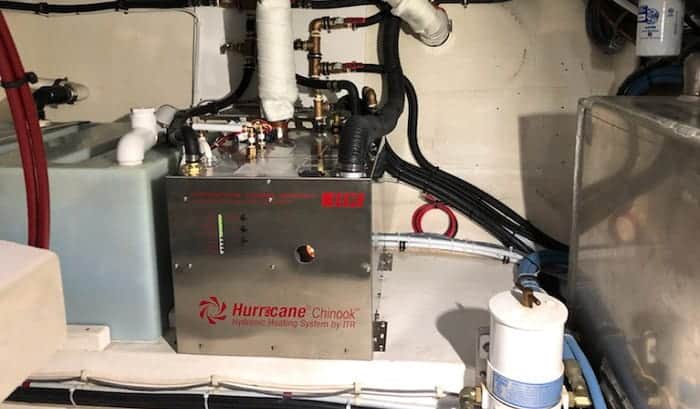
Warm or hot water is essential when sailing as you utilize it for showering and washing up. Just make sure that you get the right heater size so that you can optimize the usage and performance. Unlike residential heaters, marine water heaters don’t consume a lot of energy.
There are numerous marine hot water heaters that you can find. You can avoid confusion by reading this comprehensive review so you’ll be oriented with the important features. Consequently, you can select the most suitable for your boat.
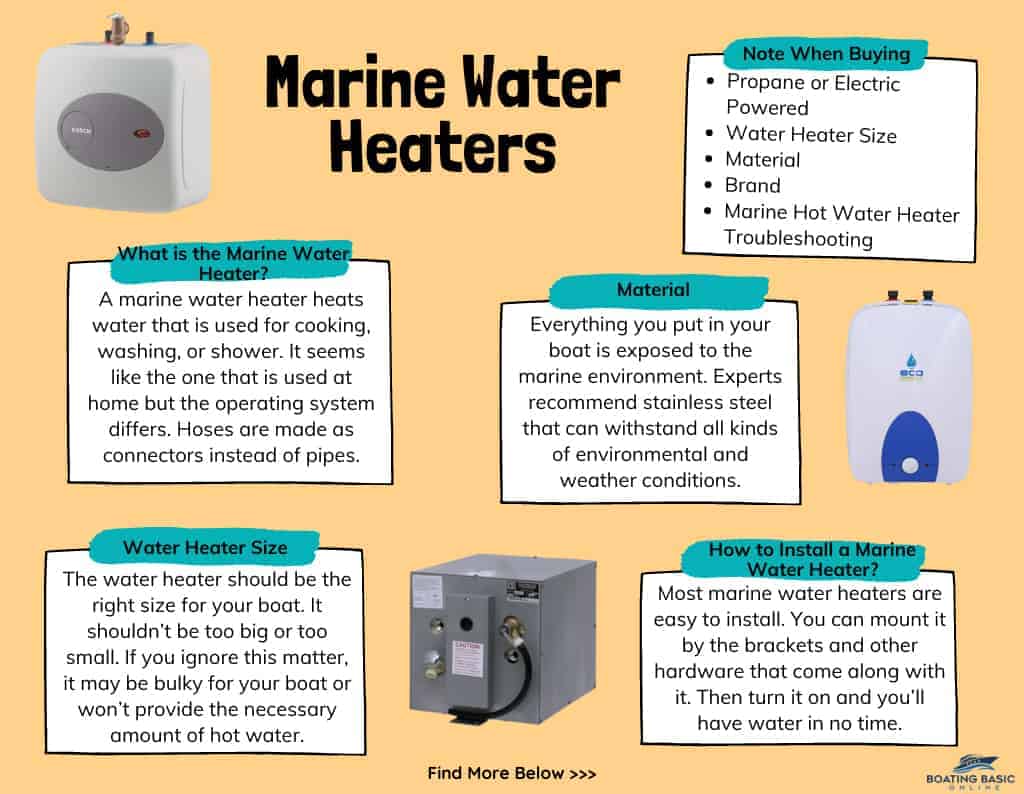
- Works with solar power
- Provides hot water in 5 minutes
- Easy installation
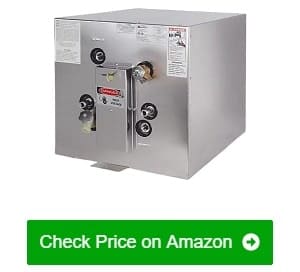
- Doubles the supply of hot water
- Has good-quality parts
- High-quality construction
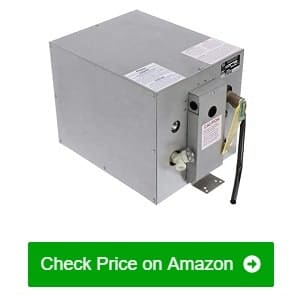
- Durable
- Has 2-year warranty
Table of Contents
1. Whale Premium Water Heater
2. kuuma 11g 120v front exchanger, 3. whale premium water heater capacity, 4. kuuma water heater rear heat exchanger, 5. bosch 7738004996 electric water heater, 6. ecosmart eco mini electric heater, 7. kuuma 120v 6 gallon water heater, 8. whale f700 water heater, 9. bosch es8 tronic 3000 t water heater, 10. whale 68954 seaward hot water heater, 11. suburban 52747a water heater, 12. whale seaward zxc-f600wcwe water heater, factors to consider when choosing marine water heaters, what is the marine water heater, who makes the best marine water heater, how to install a marine water heater, which water heater is better rheem or ao smith, best marine water heater reviews.
You’ll find this product from Whale which is a part of Attwood in several marine water heater reviews due to its dependability. It’s an efficient hot water supplier in my sailboat. I sometimes use solar power to make it work.
When it’s time to take a shower, I only need to wait for 5 minutes to get warm water. That’s why I call it an instant heater! Aside from quickly turning water hot, it can supply you with plenty of it. To prevent water from becoming scalding hot, I added an automatic thermostatic mixing valve to the outlet.
The installation is easy as I mounted it horizontally. It’s like doing plug and play as everything is a match. No tiresome process is required before reaping benefits from this 6-gallon heater that only requires 120V. It’s a relatively compact water heater. Thus, you don’t need a lot of space for it.
- Produces plenty of water supply
- Easy installation or horizontal mounting
- Compact so it take up a lot of space
- Durable because of its premium components
- Adding automatic thermostatic mixing valve to the outlet so that water won’t be scalding hot
Due to this quick marine water heater, the supply of hot water in my boat doubled. It’s lightweight with fiberglass sheets for insulation. This design allows me to remove the case to minimize the space that it occupies.
I was happy that I am able to connect it to the freshwater cooling system of the boat’s engine. Water heating can be done with 110V AC when the engine is not running. However, it’s recommended to fill and cap the pipe with antifreeze when you let it run with AC.
You’ll find black, white, and green wires that have good quality. If you have the same wires in your boat, it’s easy to connect them. Installation is manageable in my case. I figured out what to do after I saw the parts. It has a nice recirculation system that works in producing hot and cold water.
- Lightweight and space saver by removing the case
- Can be connected to the freshwater cooling system of the boat’s engine
- Has good quality parts
- Has a recirculation system for hot and cold water
- Durable due to its high-quality construction
- Needs antifreeze in the pipes when connected to 110V AC
With the 11 gallon capacity of this water heater, I have enough hot water onboard whenever I need it. I think that Whale is a part of Attwood company as the two-year warranty card is addressed to the latter.
It’s a great replacement for my previous heater even though it’s a tad bit larger. Luckily, the plates can be flattened against the case to make some room. This results in decreasing the depth. Although it’s another task, installation is fairly easy. Screwing down plates and horizontal mounting is not that difficult.
Operating this heater starts with 120 volts or 220 volts. It’s flexible when connecting to power sources as it has extra ports. Thus, there are options for you to plug it into the engine coolant or run off the heat engine. The second alternative works even though the boat is underway and it functions without the help of a generator.
- Provide enough supply of hot water onboard
- Fairly easy installation
- Has extra ports for different power sources
- Durable due to rugged construction
- Ignition is protection to prevent harm and accident
- Has plates that may be a tad bit larger than the designated place
- Water turns hot after 45 minutes
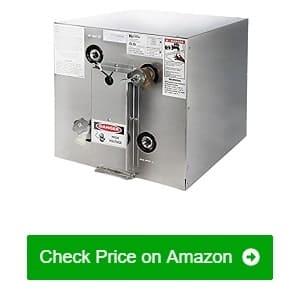
Since the exterior shell of this is composed of marine-grade aluminum, it can last for several years. As I’ve used it for a year with no issues, it’s much better than the other one. I didn’t have to make adjustments as its measurement is similar to my previous water heater.
This has a 6-gallon capacity that never fails to provide the necessary amount of hot water. Thanks to its large diameter and 1,500W heating element! There are other features that I like about it. A high-temperature limiter is present and it has an automatic reset. Also, the circuitry is ignition protected for safe operation.
The heat exchange barbs are found at the back while the fittings and connections are in the front. Installation is relatively easy so I didn’t have to spend a lot of time when going through all the steps. This heater can start working through AC power or engine heat when your vessel is underway.
- Composed of marine-grade aluminum to last for several years
- Provides enough hot water due to 1,500W heating element
- With temperature limiter and automatic reset feature
- The circuitry is ignition protected for safety
- Relatively easy installation
- Works with AC power and engine heat
- Capping off the heat exchanger with anti-freeze so it can supply the needed amount of hot water
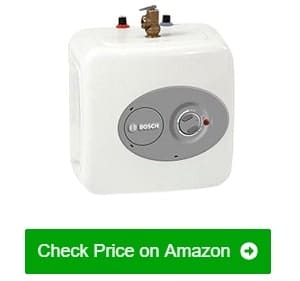
Although this is a mini-tank water heater, it has a number of great features. First and foremost, it’s capable of giving off instant hot water as it can maintain the high temperature. It fascinates me because I don’t need to wait for even a single minute. The warmth is good enough for my outdoor showers. I also use it when washing dishes.
It stands out when it comes to the quantity of hot water. Five to seven gallons can be obtained at 98 degrees Fahrenheit.
Be aware that it may be too hot at first and may likely be so for the first gallon. Despite this minor drawback, it can serve two sinks without compromising performance. Also, the recovery rate is fast. With these abilities, I can say that it’s perfect for heating water from distant faucets.
Since this is tankless, the mounting options are not limited. You may place it on the wall, shelf, or floor. In any way you do it, it will always be easy because of its size. The same reason helps me avoid wasting water as I only get what I need. Just like any other RV marine electric tankless water heater, this saves energy as you only heat the water when necessary.
- Gives hot water in an instant even for two faucets at the same time
- Can provide five to seven gallons of hot water
- With a fast recovery rate
- Mounting options are not a limited and easy installation
- Separate warranties for the unit and the parts
- Makes you save water and energy
- The first gallon of water may be too hot
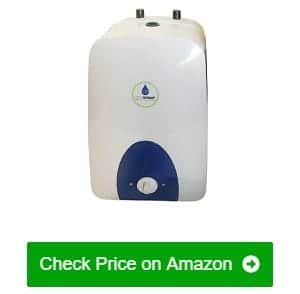
I read some marine hot water heater reviews which convinced me to buy this item. The efficacy of this equipment is not only for household use but onboard as well. Eventually, I wasn’t disappointed. I only need to count seconds to have hot water. Moreover, the performance remains incredible even with a distant faucet.
When onboard, I need hot water to complete menial tasks and quick washing. As such, this heater is a reliable companion. Even my boat bidet with a sprayer became functional because enough supply of warm water came out of it. What’s even better is that this mini tank can give you both hot and warm water.
I like that it’s compact and lightweight with a sleek design and a temperature display. The size of this tank reminds me of a toaster oven. It has pretty good insulation so no energy is wasted. Plug it into a 110-volt outlet and it will start working.
- Heats water in a matter of seconds
- Works on a distant faucet
- Gives water instantly so perfect for quick washing and simple tasks
- Can provide both hot and warm water
- Compact and lightweight with a sleek design and a temperature display
- Has good insulation to not waste energy
- Need to add couplers and tape to secure the connection
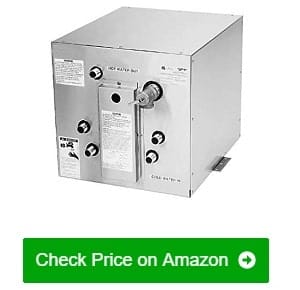
Water heaters made by Kuuma are known for their durability. They are made of aluminum to ensure that you can use them for many years. So, I didn’t think too hard before buying this one. My hunch was right as it turned out to be the perfect replacement for the previous heater in my 1985 O’Day 28 sailboat. I’m enthralled by how it perfectly fits into the cockpit locker due to its side mount feature.
Hot water when cruising the vast sea can be both a necessity and a luxury. Thus, I was prompted to get this heater with great abilities. There are two ways to heat water due to its dual-loop feature. It can be done through the boat’s engine and shore power. When the vessel is underway, you can connect it to AC power. You may even use raw power heating.
It also promotes safe operation, especially for gasoline-powered boats. The credit goes to the circuitry that is ignition protected. There’s a limit to high temperatures and an automatic reset. Hence, you won’t be surprised with scalding hot water. Quick recovery is another wonderful ability from its 1,500W heating element.
- Durable and lasts for many years
- Suits old model vessels
- Works with different power sources
- Promotes safety operation
- Quick recovery of hot water
- Uncomplicated installation
- Separately buying the necessary hardware
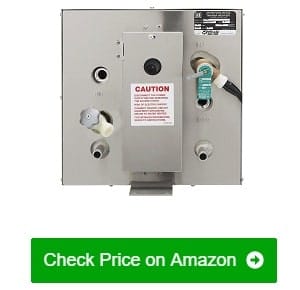
The need to have a huge supply of hot water made me buy this product. You can get 6 gallons or 23 liters from it. It has a thermostat that regulates the electric heating element while it can also produce cold water if you need it.
When heating water, it can reach a temperature of 140 degrees Fahrenheit. But with the temperature-pressure relief valve, the water can’t get too hot. A bilge pump is also added to stop electricity sparks. Since it can dispense both hot and cold water, its design includes waste management.
You can rely on its durability as the inner tank is composed of aluminum and the exterior is of marine-grade stainless steel. These materials guarantee long-term service and strength to face the rigors of the marine environment. That’s why the manufacturer has the confidence to give a two-year warranty to all users.
The double-walled construction is also great as it protects the freshwater supply from contamination. Thus, I don’t worry too much about the water that I keep in my boat.
It’s convenient to just focus on the same area when working on the tank since the fittings and heat exchanger barbs are all situated in the front. Therefore, both the installation and marine hot water heater troubleshooting are easy. Hold-down brackets complete the horizontal mounting of this heater and it’s done with no troubles.
- Contains a huge supply of hot or cold water
- Has parts for safe operation, waste management, and prevention of contamination
- Durable for long-term service
- Has a two-year warranty
- Easy installation and troubleshooting
- Hot water retention for 10 hours
- Very first water release is too hot
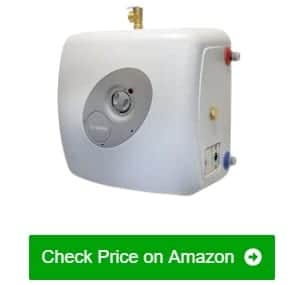
I like this product very much as it’s an effective marine tankless water heater. In just 35 minutes, the entire tank of 7 gallons is filled with hot water! Using it gives me so much ease and convenience. I don’t have to turn it on again and again as the water stays hot.
Installation is super easy since it’s substantially hardwired. I think everyone can do it with no difficulty at all. It can also produce cold water. You may mount it horizontally and vertically. But make sure to prepare enough space for it as it’s not exactly mini. Still, you have the freedom to put it on the wall or the floor.
I mounted it with PEX and once it’s done, hot water came out in just 9 seconds. Thus, it’s right to say that it heats up quickly. The temperature that it handles ranges from 65 to 145 degrees Fahrenheit. I can customize the temperature of hot water as there’s a thermostat swing.
- Can make 7 gallons of hot water
- Easy and convenient to use
- Super easy installation
- Heats up quickly and fast
- With a thermostat swing to customize the temperature
- Energy-efficient even though the faucet is far from the tank
- Prepare enough space before installation as it’s not mini
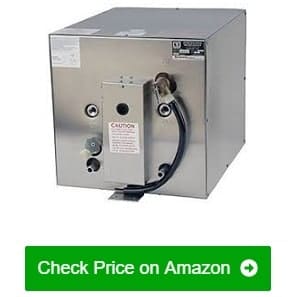
I bought this water heater to make sure that I always have hot water in my boat. Its 11-gallon capacity caught my attention among several other options in the market. It’s a product of the latest technology so it’s capable of bearing 1,500W.
It has a robust construction to withstand harsh marine environments and corrosion. So, I can rely on it in rendering the same performance through time. It simply means unrivaled durability. I can’t help but be astonished by its double-wall heat exchangers and integrated pressure relief valve. Both of these parts guarantee the security of water inside it and the preservation of heat.
Safety operation is also expected from this tank because of its protected ignition. The last thing that I want is to have a piece of equipment that acts up in my boat while sailing. Thankfully, this water heater gives me peace of mind. There’s a safety control to stop the build-up of unsafe temperatures as well.
- Has a large capacity to not run out of hot water
- Has a robust construction for durability
- With parts that keep and preserve hot water
- Safely operates with ignition protected and safety control
- Needs to be installed by two people as this is a large tank
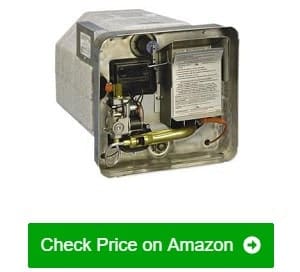
I don’t go for a tankless water heater if I want more pressure and very hot water. The things that I’m looking for are provided by a hardy tank like this one. Since I sail for a couple of days, it serves me well in providing hot water that I use for showers and washing dishes. This is also an RV marine water heater as it’s mostly used by those who permanently live in RVs.
I was able to double up my hot water supply from 6 to 12 gallons. This tank can be powered by propane and 120 volts of electricity. Although it’s big, I’ve noticed that it consumes less propane and it’s quieter too. Due to the adequate supply of hot water, there’s no interruption when taking a shower as long as the power source doesn’t cease to work.
Before mounting this heater, I flushed it first to ensure that the inside is clean. I did some minor adjustments to the plumbing and it didn’t trouble me at all. It doesn’t take much time and effort to complete the installation. After the assembly, give the cold tap water 15 minutes to turn hot.
- A hardy water heater tank
- With a capacity of 12 gallons which means doubling up your hot water supply
- Can be powered by propane or electricity
- Consumes less propane and operates quietly
- Easy installation to produce hot water in 15 minutes
- Not prone to leaks
- Some minor adjustments on plumbing
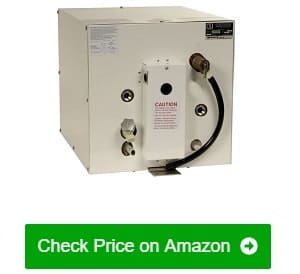
When I go sailing, I see to it that I dock my boat before sunset. But, I sometimes spend the night on the waters and return home the next day. Hence, this 6-gallon water heater is just right for my needs. It can be operated by 120 volt AC or engine coolant heat exchange.
To have constant availability of hot water, there’s a thermostat that regulates the heating temperature at 140 degrees Fahrenheit. You may also get cold water from it because of its 1/2-inch NPT.
The inner tank is made of aluminum while the exterior is of marine galvanized steel. With these premium materials, I know that this tank will be with me for a long time. Durability of a water heater is important for me so I have the assurance that it can take care of my boat’s water supply.
Set it up by horizontal mounting and hold-down brackets that are already attached to the inner tank. I did it with ease by myself. You will have to thoroughly check the fittings and heat exchanger parts to avoid any issue. Fortunately, it’s uncomplicated as they are all placed in the front of the tank.
- Can be run by electricity or a boat’s engine
- Has a thermostat that regulates water temperature
- Durable as it’s made of premium materials
- Easy mounting or installation
- With valves for safety operations
- Thorough checking of the fittings during installation
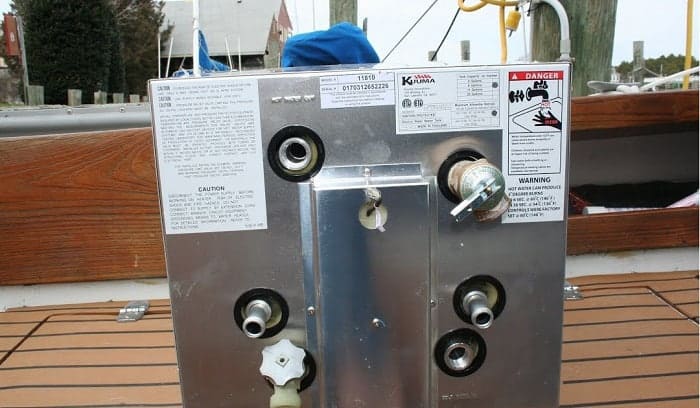
Before buying a water heater, there are two main things that you have to consider. Of course, the size of the heater should match your boat’s size so you have enough space for it. The next thing you have to think about is the number of people onboard. Hold your horses as you can’t just buy a 12V marine water heater if you have a lot of people cruising with you! There are other aspects that you have to ponder as well.
Propane or Electric Powered
Most of the water vessels these days have an electrical system. So, getting an electric-powered water heater is not troublesome. You should know that the heater will always be running without limitations if it’s run by electricity.
When it comes to a propane-powered heater, it has a quick recovery rate even when the temperature is low. You’ll also save on running costs. Some think that electric-powered ones tend to last longer. Nevertheless, propane-powered heaters can keep up.
On the brighter side, you’ll find exceptional water heaters that can be powered by both propane and electricity. So, at any time, you can switch to the power source that suits you best.
Water Heater Size
The water heater should be the right size for your boat. It shouldn’t be too big or too small. If you ignore this matter, it may be bulky for your boat or won’t provide the necessary amount of hot water. If you don’t have ample space for it, go for the tankless type as it’s compact.
Everything you put in your boat is exposed to the marine environment. In this matter, you should consider your boating routine and preference. Experts recommend stainless steel that can withstand all kinds of environmental and weather conditions.
A brand is appealing if it becomes popular due to the satisfaction that it gives buyers. So, settle for a company that has a good reputation and you won’t be disappointed with the quality of their products.
Marine Hot Water Heater Troubleshooting
Be concerned about troubleshooting as it’s important to get the heater fixed in case something goes wrong. Research the product to see if you can handle the necessary troubleshooting steps.
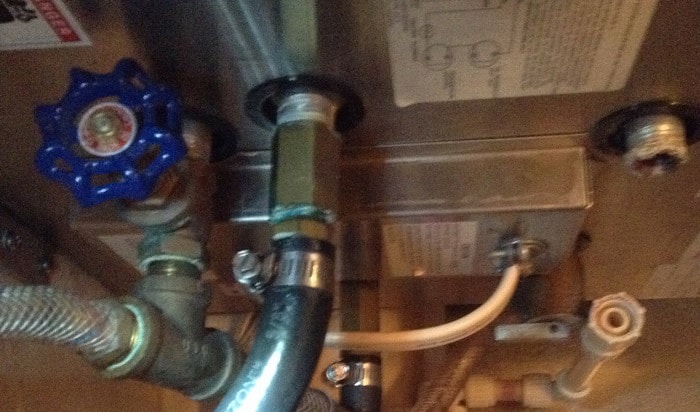
A marine water heater heats water that is used for cooking, washing, or shower. It seems like the one that is used at home but the operating system differs. Hoses are made as connectors instead of pipes .
There are two ways to heat a marine water heater. You can let it run by AC power or marine engine heat. This equipment only needs minimal power as any excess can disrupt ignition. It usually comes as a built-in but selections are in various sizes, patterns, and durability.
Companies become competitive these days. Thus, it’s not only the popular ones that excel in making quality products. Aside from the commonly known Superstor marine water heater and Isotemp water heater, Whale, Kuuma, Bosch, Ecosmart, and Suburban are trustworthy brands in terms of creating marine water heaters.
Most marine water heaters are easy to install. You can follow the steps in the instructional manual but in some instances, you may not need it at all.
You can mount it by the brackets and other hardware that come along with it. Then turn it on and you’ll have water in no time.
Rheem and AO Smith are known as makers of quality water heaters. The former also specializes in crafting air conditioning and air cooling systems while the latter only focuses on water heaters. AO Smith has better customer service than Rheem, which is the primary difference between them.
After reading this review, you know the importance and value of the best marine water heater. It’s an investment with a load of benefits. Hot water is a necessity but it can be luxurious when you’re cruising with your boat. It can make a huge difference in your sailing experience due to the immense comfort that it brings.

“I am James Harvey – founder of Boating Basics Online. It is established with the drive to help out first-time boaters, which are those desiring to explore their way through the water. So if you are new to boating, start from here with me. “
Marine Water Heaters Ultimate Guide: All You Need to Know for Efficient Heating Onboard
Marine water heaters are an essential appliance for any boat or recreational vehicle, providing hot water for various uses such as washing up, showering, and even cooking. These heaters are designed to be compact and lightweight, taking into consideration the limited space available onboard vessels. With numerous options available in the market, it can be challenging to choose the right marine water heater for your specific needs.
In this ultimate guide on marine water heaters, we will explore the different types of heaters available, their features, and the key factors to consider when making a purchase. By the time you finish reading, you will have a good understanding of marine water heaters and be better equipped to make an informed decision on which model is best suited for your boat or RV.

Types of Marine Water Heaters
Marine water heaters are an essential part of any boating experience, as they provide hot water for various purposes, such as cooking, bathing, and cleaning. There are three primary types of marine water heaters available on the market: electric water heaters, engine-connected heaters, and hydronic heaters. Each type offers different benefits and suits specific needs, depending on the boat's size and power capabilities.
Electric Water Heaters
Electric marine water heaters rely on an electric heating element to heat the water. These units are typically connected to the boat's electrical system, either 120V AC or 12V DC, depending on the model. They provide a reliable source of hot water with minimal maintenance requirements. Some popular electric marine water heaters include the Whale 6-gallon Premium Water Heater and the Kuuma 6G 120V Rear Heat Exchange . Electric water heaters are ideal for boats with a stable electrical supply.
Engine-Connected Heaters
Engine-connected marine water heaters use the heat generated by the boat's engine to heat the water. These heaters often feature a double-walled heat exchanger system that transfers heat from the engine's cooling system to the water tank. A popular example of this type of heater is the Whale Marine Water Heater - Premium . Engine-connected heaters are a highly efficient option for boat owners who frequently operate their engines, as they make use of the engine's waste heat.
Hydronic Heaters
Hydronic marine water heaters use a closed-loop system that circulates heated water or coolant throughout the boat's interior. These systems often have multiple heating zones, with individual temperature controls for each area of the boat. Popular manufacturers, like Webasto , offer a range of models to suit different boat sizes and heating requirements. Hydronic heaters tend to be more fuel-efficient than electric heaters, as they use a smaller amount of energy to maintain the desired temperature. They are suitable for boaters who prioritize fuel efficiency and have the necessary space to install the heater and its required components.

Key Features to Consider
The capacity of a marine water heater is an important factor to consider, as it determines the amount of hot water available for use on your boat. Capacities typically range from 6 to 20 gallons, so choosing the right size depends on your boat's requirements and the number of people on board. A smaller capacity may be sufficient for smaller boats or short trips, while larger capacities are more suitable for bigger boats or extended trips.
Power Source
Marine water heaters can be powered by a variety of sources, including electricity, engine heat, and propane. Electric marine water heaters, like the Kuuma 6G 120V , rely on an immersed heating element to warm up water, while engine-powered heaters connect to the boat's engine to utilize its heat. Propane heaters, on the other hand, use a propane burner to heat the water. Each type of power source has its own advantages and drawbacks, so choose one that best suits your boat's setup and your specific needs.
Materials and Construction
The materials used in the construction of a marine water heater can also impact its long-term durability and performance. Many marine water heaters feature stainless steel or galvanized steel tanks, as these materials are known for their corrosion resistance and longevity. For example, the Whale F600 Water Heater has a galvanized steel tank, while the Kuuma 11G 120V is made of stainless steel. It's important to select a water heater made from high-quality materials that can withstand harsh marine environments.
Safety Features
As with any appliance, safety is a crucial consideration when choosing a marine water heater. Look for water heaters with built-in safety features, such as overheat protection, pressure relief valves, and ignition protection. These features can help prevent malfunctions and potential accidents while onboard your boat.
Ease of Installation
Lastly, consider how easy it is to install a marine water heater on your boat. Some heaters, like the Kuuma 6G 120V side mount front exchanger , offer more flexible installation options, making them suitable for tight spaces or corners. Others may have more specific requirements for placement, which can be a challenge in limited spaces. Ensure that the water heater you choose can be easily installed on your boat without requiring significant modifications.

Popular Marine Water Heater Brands
Several well-known brands in the marine industry offer high-quality water heaters suitable for various types of boats. In this section, we will discuss a few popular marine water heater brands to consider for your boating needs.
Kuuma: Kuuma is a trusted name in marine water heaters, offering reliable products designed for marine applications. Their 6G 120V Side Mount Front Exchanger and 11G 120V Front Exchanger SS are popular models known for their durability and performance. Kuuma water heaters come in various sizes and configurations, making it easy to find the right one for your specific needs.
Whale: Whale is another renowned brand in marine water heaters. They produce durable and efficient heaters suitable for boating enthusiasts. The Whale F600 Water Heater , with a 6-gallon capacity and front heat exchanger, is one of their popular models. Whale water heaters are also available in various sizes and configurations to meet diverse boating requirements.
Raritan: Raritan Engineering is known for its high-quality marine water heaters designed to perform in harsh environments. Their 1700 series is engineered specifically for marine applications and offers reliable performance with dockside recovery rates of up to 18 gallons per hour. The adjustable thermostat in Raritan water heaters enables precise temperature control, making them an excellent choice for boaters.
In conclusion, Kuuma, Whale, and Raritan are some of the popular marine water heater brands to consider when upgrading or installing a new system on your boat. Each brand offers a range of products tailored to suit various needs, ensuring that you can find the right water heater for your specific situation. Keep in mind that researching and comparing different options is vital to making an informed decision and getting the most value for your investment.

Maintenance and Troubleshooting
Regular maintenance.
Proper maintenance is crucial to ensure the longevity and efficiency of marine water heaters. Regularly inspecting the water heater and its components can prevent potential issues and costly repairs. Some essential maintenance tasks include:
- Checking and replacing the water heater anode when necessary. The anode protects the tank from corrosion, and wrapping Teflon tape around the threads of the anode can help prevent leaks during reinstallation ( BoatUS ).
- Examining pipe joints and hose connections for leaks. Using Teflon tape or pipe joint compound can help prevent dripping, and hose clamps ensure tight seals on hose barb-to-hose connections ( Practical Sailor ).
- Ensuring proper and consistent supply of gas and electricity to the water heater. Test for stable gas supply by lighting a stovetop burner, and use a voltage meter to check that input to the heater is at least 10.5 volts ( RV Repair Club ).
Common Issues and Solutions
Marine water heaters may experience various problems, which can often be resolved with some basic troubleshooting:
| Issue | Solution |
|---|---|
| Insufficient hot water | Check the thermostat setting and adjust if necessary. Also, inspect for potential leaks in the plumbing system or faulty heating elements. |
| No hot water at all | Verify that the water heater has proper gas and electrical supply. Ensure that the heating element is functioning correctly and that the thermostat is set at the desired temperature. |
| Leaks | Inspect pipe joints, hose connections, and the water heater tank for any signs of leakage. If a leak is found, applying Teflon tape or pipe joint compound and tightening connections can help resolve the issue. |
| Corrosion | Regularly check and replace the water heater anode to protect the tank from corrosion. Use Teflon tape around the threads of the anode to prevent leaks during reinstallation. |
Consulting the water heater's manual and seeking professional assistance when unsure about diagnosing or resolving an issue is recommended. Regular maintenance and diligent troubleshooting can help extend the life and enhance the performance of marine water heaters.

Environmental Considerations
When selecting a marine water heater, it is essential to consider the environmental factors that will impact its performance and longevity. Marine environments expose water heaters to high-humidity, aggressive water conditions, and other harsh factors that can affect their functionality and reliability.
One major concern in a marine environment is corrosion. It is crucial to choose water heaters that have corrosion-resistant components to ensure long-lasting performance. Many top-quality marine water heaters, such as those offered by Torrid , include glass-lined inner tank vessels to mitigate the risk of corrosion and reduce bacterial buildup.
Eco-friendly operation is another important environmental consideration. Look for water heaters that meet stringent energy efficiency standards and provide optimal heat transfer without excessive energy consumption. Additionally, these heaters should have minimal noise output to limit noise pollution in the surrounding marine environment.
Furthermore, insulation plays a crucial role in maintaining the water temperature and reducing heat loss. Marine water heaters with good insulation, like the polyurethane foam used in Sigmar heaters , can still have water heated at more than 80-degrees after 20 hours of shutting off the heating element.
Last but not least, proper installation is key in minimizing potential environmental risks. Ensuring that the water heater has a secure mount on a well-reinforced surface can help prevent potential damage and instability during rough seas, as mentioned by Practical Sailor .
Considering these environmental factors will help guide boat owners in choosing a suitable marine water heater that is reliable, efficient, and durable in the challenging marine environment.

In this ultimate guide , we have discussed various aspects of marine water heaters, from the top-rated models to the factors that should be considered when making a purchase. The 5 best marine water heaters we reviewed, such as Whale Premium Water Heaters and Kuuma Water Heaters, showcase the options available to boat owners.
When investing in a marine water heater, factors like size, capacity, heat exchanger type, and power source are crucial in making the right choice. For instance, smaller boats may benefit from a compact design like the Cobalt Aquatics Neo-Therm , while larger vessels may need heaters with greater capacity.
An efficient marine water heater not only provides comfort but ensures a pleasant and warm experience during long sailing expeditions. Since various models are available on the market, carefully weighing your specific needs and preferences will lead to a suitable purchase that will cater to your boat's heating requirements.
Lastly, proper installation and maintenance of your marine water heater are key to reliability and longevity. Make sure to follow the manufacturer's guidelines and consult professionals when necessary. By taking all these factors into account, you can select and maintain the ideal marine water heater tailored to your unique needs.
Related Articles
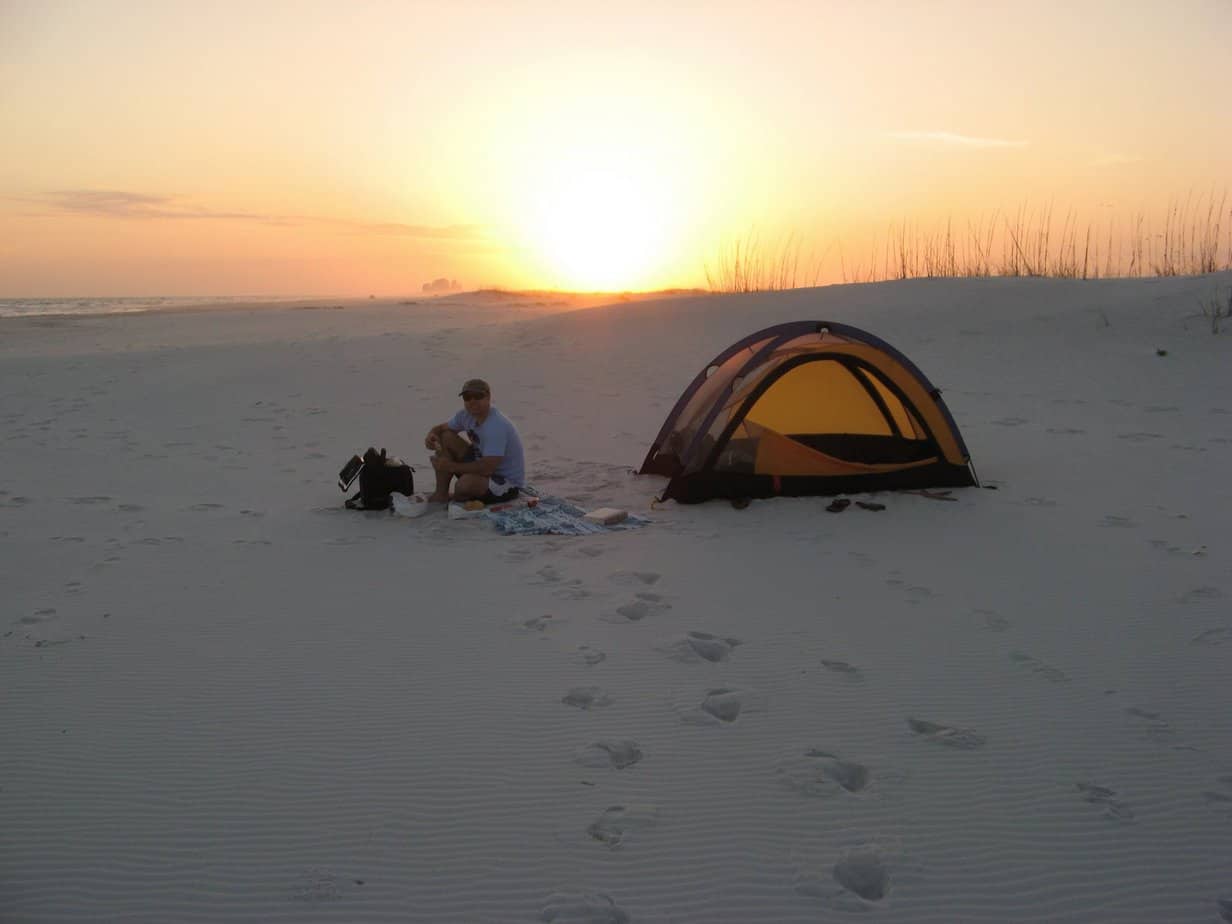
Beach Camping Florida: Your Guide to Sunshine State Shorelines
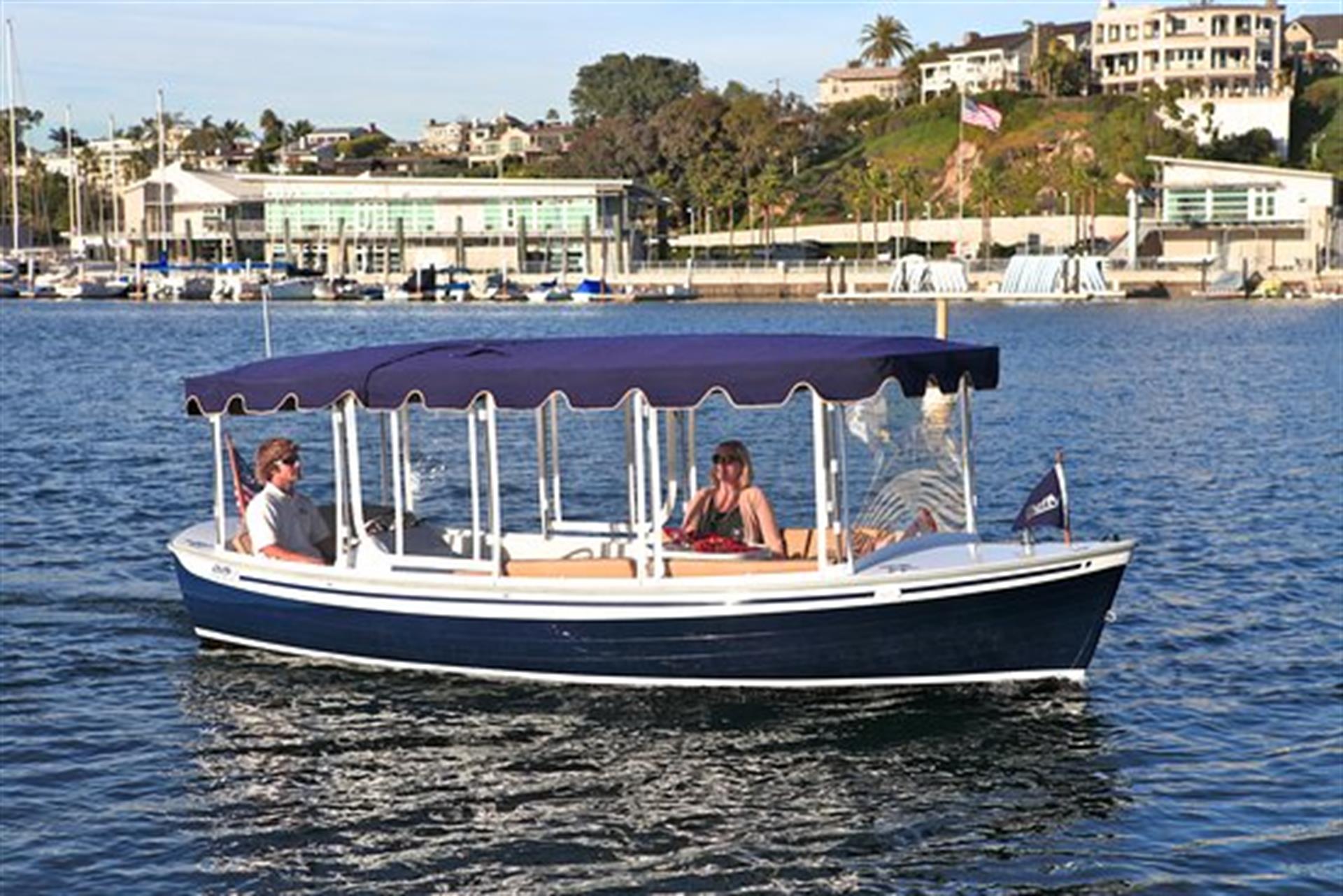
Duffy Boat: The Ultimate Guide to Electric Boating Experiences
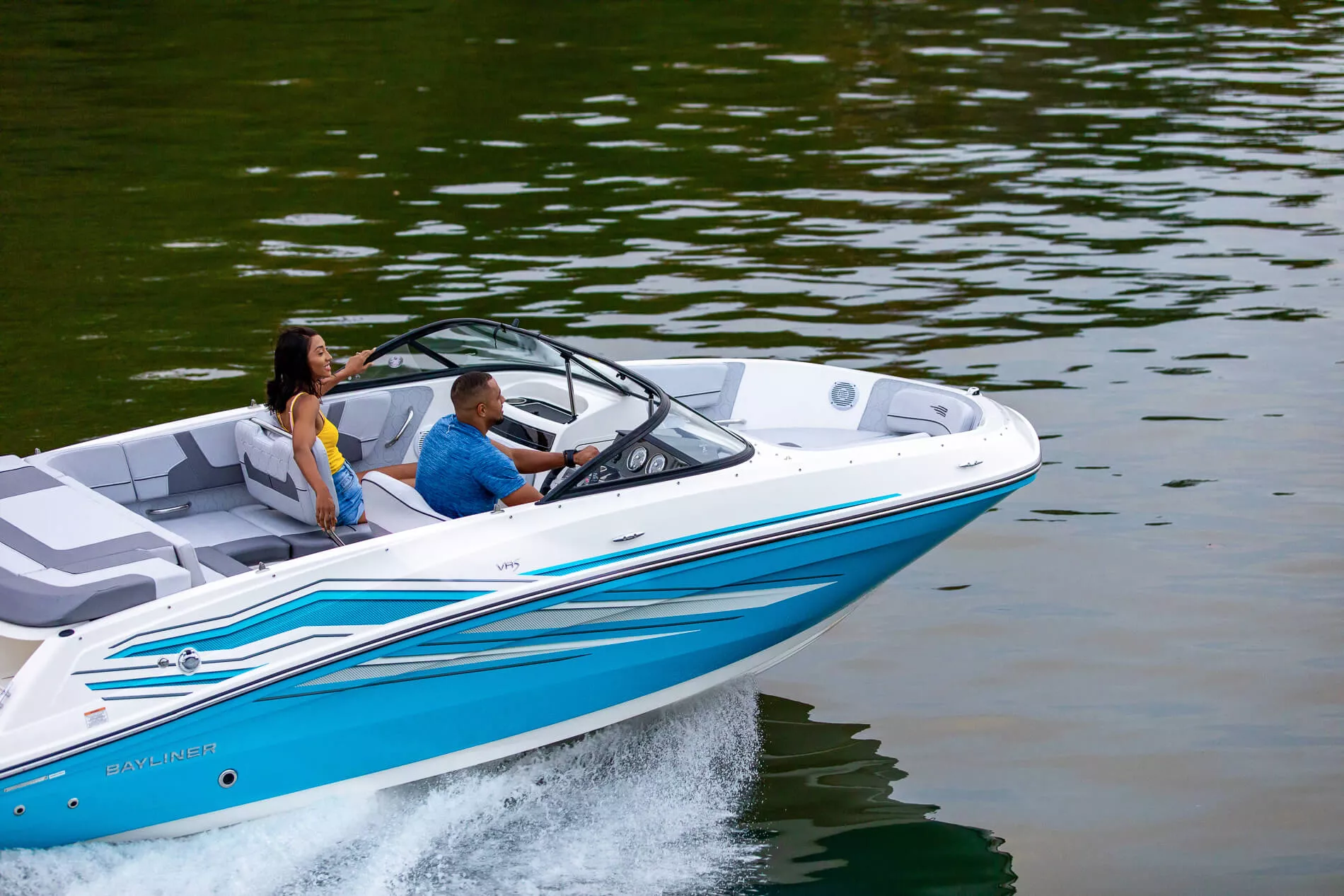
Bayliner Boats: Ultimate Guide to Models, Performance, and Features

Cubera Snapper: Expert Tips for Catching and Cooking

Starlink for Boats Ultimate Guide: Seamless Connectivity on the High Seas
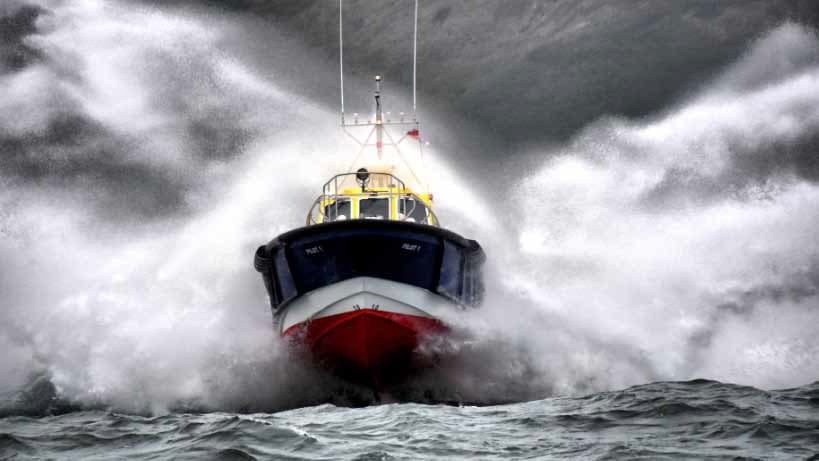
The Following Are Examples of Reckless Operation Except: Common Misconceptions Debunked

Sombrero Reef: A Guide to Florida's Underwater Treasure

CATANA Group Unveils YOT, the Fresh Power Catamaran Sensation on the Seas

Please verify you are a human
Access to this page has been denied because we believe you are using automation tools to browse the website.
This may happen as a result of the following:
- Javascript is disabled or blocked by an extension (ad blockers for example)
- Your browser does not support cookies
Please make sure that Javascript and cookies are enabled on your browser and that you are not blocking them from loading.
Reference ID: 78ea2655-6777-11ef-9e78-18463a795628
Powered by PerimeterX , Inc.
- Types of Sailboats
- Parts of a Sailboat
- Cruising Boats
- Small Sailboats
- Design Basics
- Sailboats under 30'
- Sailboats 30'-35
- Sailboats 35'-40'
- Sailboats 40'-45'
- Sailboats 45'-50'
- Sailboats 50'-55'
- Sailboats over 55'
- Masts & Spars
- Knots, Bends & Hitches
- The 12v Energy Equation
- Electronics & Instrumentation
- Build Your Own Boat
- Buying a Used Boat
- Choosing Accessories
- Living on a Boat
- Cruising Offshore
- Sailing in the Caribbean
- Anchoring Skills
- Sailing Authors & Their Writings
- Mary's Journal
- Nautical Terms
- Cruising Sailboats for Sale
- List your Boat for Sale Here!
- Used Sailing Equipment for Sale
- Sell Your Unwanted Gear
- Sailing eBooks: Download them here!
- Your Sailboats
- Your Sailing Stories
- Your Fishing Stories
- Advertising
- What's New?
- Chartering a Sailboat
- Boat Water Heater
Get Free Hot Water from a Boat Water Heater
A boat water heater can usually be retro-fitted without too much difficulty, as long as your boat has a freshwater cooled engine. This type of marine engine, unlike a raw seawater cooled engine, has a separate closed system with its own header tank, which is then cooled by a freshwater/seawater heat exchanger.
The other requirement is for a pressurised domestic water system. A manually pumped system, laudable though it is, just won't do - but it's usually a straight forward affair to convert it to a pressurised system.
On a boat thus equipped, you can get that rare commodity; something for nothing - and you should take advantage of it.
Any boat that uses its engine fairly regularly produces hot water as a by-product of the combustion process, and it's free. Once you've shelled out for the equipment that is - which in this case is a boat water heater known as a marine calorifier.
This device is effectively an insulated heat exchanger, which plumbed into the engine cooling water system will transfer heat from the engine into the domestic water supply.
A typical hot and cold domestic water installation is shown in the illustration below.
How a Boat Water Heater System Works
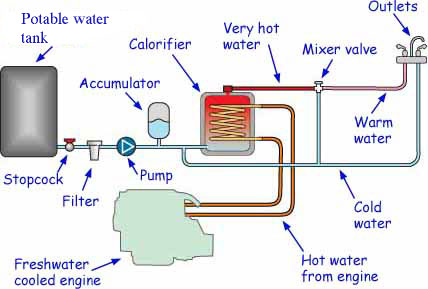
Artwork by Andrew Simpson
This system incorporates both a pump and an accumulator. Most water pressure pumps maintain steady pressure by cycling on and off, producing a pulsed delivery.
The accumulator tank, containing water and air - usually but not always separated by a diaphragm - absorbs this pulsation and provides steady flow. Some pump manufacturers now produce microprocessor-controlled variable-speed pumps which eliminate cycling and make the accumulator tank redundant.
The mixer valve operates thermostatically, introducing a metered amount of cold water into the outlet flow, thus maintaining regulated temperature and conserving hot water.
The pipework from the engine should be as short as possible to minimise heat loss, and should be installed lower than the level of the engines header tank.
Calorifiers are well insulated and will continue to provide warm water for an hour or two after the engine has been turned off, but if you haven't run the engine for a much longer period, turning on the hot tap won't produce the desired result.
Immersion-Type Water Heaters
Electric immersion heaters, much like the larger versions we're accustomed to at home, require AC power, so unless you've got a generator aboard their use is restricted to when you're alongside and hooked-up to an onshore supply.
Immersion heaters are often combined with a calorifier in a single unit.
The stainless steel Isotherm units shown here are the immersion/calorifier type and are equipped with a thermostat.
In immersion heater mode, they draw around 6.5A at 120V.
Hot Water from the Sun!
Intended for campers, but perfect for sailors cruising in warm, sunny climes.
Cheap and effective - every cruising sailor should have a couple of these on board!
Gas Water Heaters
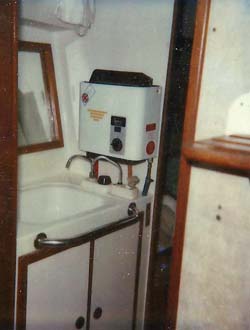
Bulkhead mounted gas water heaters like the one shown here are no longer popular on sailboats, many skippers believing that they're just too plain dangerous.
If you do decide to invest in one of these however, make absolutely sure that it has an automatic low gas pressure cut-off switch and a flame failure device fitted, and it's properly serviced and regularly maintained.
I used to have one on a previous boat - this one in fact, on my Nicholson 32 'Jalingo' and lived to tell the tale.
But would I have another? No, definitely not.
In fact I'm not even going to tempt you with an example.
My advice? Don't touch them, and if you've got one — get rid of it!
Other Plumbed-In Systems you may want to take a look at...

Which Type of Boat Fridge Is The Most Efficient?
The top opening boat fridge is reputed to be more efficient than the front opening type, but that may not be the case - and here, amongst other boat refrigeration considerations, is why
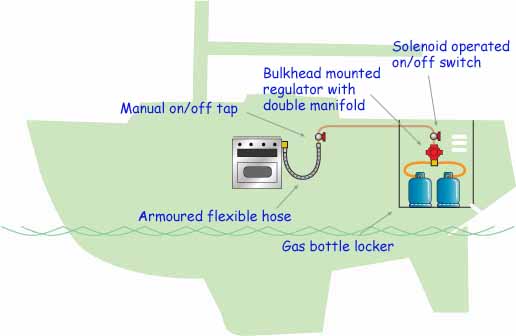
Not All Gas Boat Cookers Are Safe For Use At Sea
Good quality gas boat cookers go a long way towards protecting the cook from the very real risks of cooking at sea. Here are the essential safety features you should look for

Which Boat Galley Layout Is Best for Offshore Sailing?
A properly thought-out boat galley is a key component of an offshore cruising boat. So where should it be located, and what's the best arrangement for the individual galley components?
Recent Articles
Apla 42 Sailboat Specs & Key Performance Indicators
Aug 30, 24 02:51 AM
Ovni 445 Sailboat Specs & Key Performance Indicators
Aug 29, 24 03:44 AM
Catalina 34 Sailboat Specs & Key Performance Indicators
Aug 29, 24 12:14 AM
Here's where to:
- Find Used Sailboats for Sale...
- Find Used Sailing Gear for Sale...
- List your Sailboat for Sale...
- List your Used Sailing Gear...
Our eBooks...

A few of our Most Popular Pages...

Copyright © 2024 Dick McClary Sailboat-Cruising.com
Better Sailing
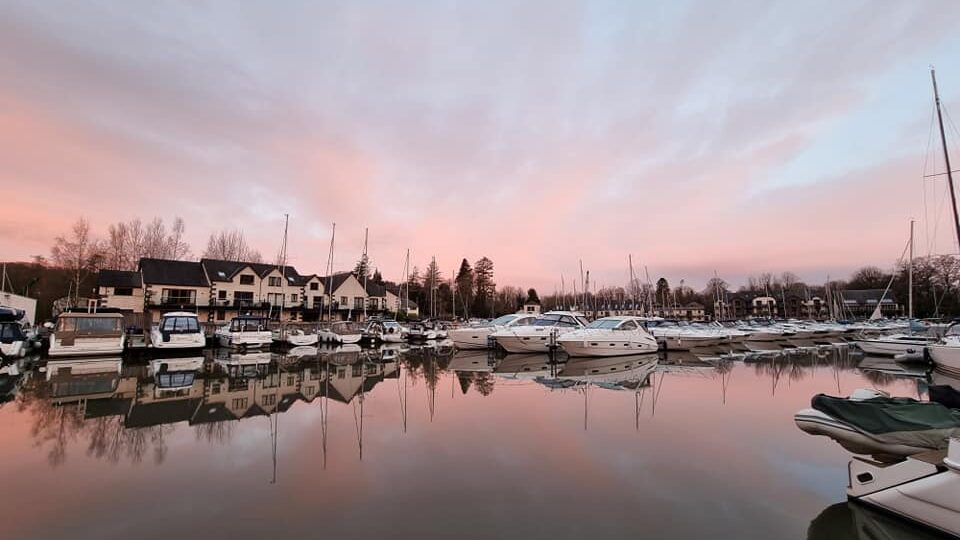
Best Ways to Heat a Liveaboard Sailboat
For most sailors, winter is the end of the boating season. They put the boat into storage and go back to routine life on land for some time. But, for liveaboards, winter doesn’t mean that they will stop sailing or live on their boat. Living aboard your boat has many advantages and also disadvantages, as most things in life. The most important thing about living aboard is that you live closer to nature, avoid routine life, and learn to live independently. So, as for heating systems, boats can have a variety of them. For example, diesel heaters in the main cabin are piped into the fuel system. Or, central air conditioning with a compressor and air handler.
What is the Best Ways to Heat a Liveaboard Sailboat? In this article, I’m going to give you some information about these systems and finally come to the conclusion for which one is the best. Follow me!
Useful Information about Boat Heating Systems
Winter sailing is still a challenge for most sailors due to the more extreme weather conditions, which necessitates more preparation. Fortunately, there are many types of boat cabin heaters available that can make winter sailing more enjoyable by keeping the interior of the sailboat warm and comfortable.
As aforementioned, there are many ways that you can use order to warm the interior of your boat. These are engine heaters, electric heaters, hydronic systems, heating stoves, forced-air systems to reverse-cycle air condition systems. As you see there are numerous choices and for every budget. It’s important to note that these systems work in a different way but their function is the same. Meaning that they can use fuel or other forms of energy so as to create heat that will be therefore spread in the boat.
There are sailboats that use diesel heaters or electric heaters. Some vessels have “core” air conditioning. This means that the compressor and air handler are hidden and cold air is forced into ducts in the boat. These systems typically run on “raw water”. You can easily spot these vessels by the steady stream of water discharged overboard when their air conditioners are turned on. But, for this kind of system, you have to regularly clean the raw water filter of debris that will get from the outside water.
Others want to choose the more budget option and choose to buy a portable electric floor heater. These can work fine as well and can be stashed away in a locker when not needed. Others go for the simple option of buying a wood-burning fireplace. But, some of these cheap systems can cause problems when used in the boat and you have to be very cautious in order to avoid any unexpected incident. Let’s now see the most common heating systems for boats!
Diesel Stoves and Ranges
In case you want to invest in a good heating system and you’re not low on budget, then a Canada-made Dickinson Newport diesel stove is an excellent small boat heater. This is great as it can spread heat throughout a small vessel, until a 36 footer, in cold locations. The stoves from Canada are costly, but they are extremely reliable. A stove fan helps as this stove is small, and it’s right on the nose of what’s useful in freezing places; this is a Peltier-effect self-powered fan that blows the hot air around the cabin.
Dickinson also manufactures diesel cooking ranges and stoves which have better performance but are much bigger. As a result, this heating system will need a good chimney length, approximately 5 inches. The stainless steel flue pipe (which turns blue/gold at the bottom) provides a lot of heat, so if you shorten it, the stove loses a lot of its power. The stoves themselves are not hot, except at the top; halfway down, you can place your hand on the side of the stove. Bear in mind that the top plate and the chimney provide the heat.
Other models like the Newport use about 1.25 gallons per 24 hours when you set it at a low level. Other and bigger models which are all cooking ranges will need a couple of liters or more per day. So, we’re talking about 45 liters of diesel a week as a minimum, for 24/7 use. The Refleks, a Danish fishing boat diesel stove, is suitable for larger vessels. It produces more power but needs an 8 inches chimney. As a result, it consumes more diesel. Note that the chimney is an essential component of all diesel stoves.
>>Also Read: Best Boat Heaters
Diesel Blower Heaters
One of the best diesel blower heaters nowadays is the Chinese copies of the Eberspacher diesel hot air blower, also known as a ‘diesel parking heater’. For a 40-foot boat or larger this heater will work perfectly if it’s well insulated and when you use it at low temperatures. Prefer the 5kW version for larger boats and the 3kW for small boats. Keep in mind that they aren’t the same as each power size has a different size heater body. Furthermore, note that you have to buy the expensive version (around $250) as cheaper models tend to have missing parts, like the exhaust pipe surface mount plate. And note that these heaters don’t compare to a Dickinson stove but if you’re on a budget $250 is different than paying $1,500. There are some options on Amazon too .
Traditional Stoves
Heating stoves are still one of the most common ways to heat a sailboat, despite the fact that they’ve been around for centuries. They can use liquid fuels like kerosene, diesel, and propane, as well as solid fuels like charcoal or wood. Some heating stove systems use a direct draft system, in which fresh air is pumped through a fan. But others use a natural draft system. In this system, the air is pumped through the combustion procedure naturally.
Bear in mind that a heating stove should be in the saloon so as to radiate heat and efficiently circulate hot air. In addition, a reliable heating stove must have a damper to help in controlling the airflow. Also, an exhaust pipe is particularly important in order to withdraw the exhaust gases resulting from the combustion.
Note that most heating stoves do not use electricity. However, a heating stove with a BTU production of 7,000 to 9,700 should suffice, especially if it uses one pound of propane in about 5.5 hours. Wood or coal stoves seem to be a good idea at first as they’re cheap and powerful, around 5 or 7kW is typical. But, the amount of fuel you have to transport is too much. They’re good options only in case you have a barge because you will have enough stowage space.
Even for a 24′ boat, never buy something with less than 3kW of output as they won’t heat the cabin at all. Stoves on a liveaboard boat should usually be 5kW and they always have to be turned down. It is impossible to have too much heat, but it is possible to have too little.
Electric Heaters
If you have shore electricity, you can use all-electric or a combination of mains power and onboard heating. This would be determined by the cost per kW of your local power unit versus the cost of onboard fuel. Halogen bar fires and 500W PTC micro fan heaters are the cheapest electric heaters in terms of heat output versus cost per kW. But, they both produce smaller output, therefore you’ll need a 2kW convector or a 3kW fan heater in case you’re all-electric.
However, this option can be good if you’re sailing occasionally and not for living aboard. Electric heaters work similarly to standard home air conditioners and are usually powered by 12-volt electricity. They’re installed inside the cabin and heat the coils with electricity by the boat’s batteries. A fan draws air over the coils, which heat it up before being blown into the boat’s interior by another fan. The main disadvantage of electrical heaters is that it needs electricity, limiting your ability to travel far from the sea. This is because you’ll need to recharge the batteries from time to time, and this will easily deplete them. Check some boat heaters on Amazon here .
Halogen Bar Fires
These systems include some 400W tubes and heat directly through radiation. What they exactly do is that they don’t heat the air but they heat you. Meaning that they have small output if you use them as freestanding heaters or wall-mount heaters. However, when sitting in front of it then it will excessively heat you up. It is energy efficient in this regard since the same effect from a fan or convector heating the air will need 2 or 3KW versus the 400W or 400W x2 that one of these halogen heaters provides.
Halogen heaters come in 3 or 4 bar versions. You can use one bar at a time because it’s sufficient, and maybe two bars for 5 minutes when returning to the boat; it will be really hot! It’s worth mentioning that after a few months, the tubes will fail, so finding another one to replace is crucial. So, you shouldn’t use more than one tube at a time; and by the time it won’t work anymore, you can switch to another tube.
Bear in mind that running three bars on these heaters will be very dangerous and not good for the system. This is because the local heat is so intense that the tubes will get damaged faster, and the control panel switches are going to melt. So, this is really dangerous and you should only run it with one bar hot, or two at most.
Micro 500W Blowers
These small PTC ceramic element fan heaters are great for overnight heating or direct heating. This is because they blow directly onto the person. They generate a lot of heat for their size and power draw: roughly twice as much as you’d expect from a half-kilowatt. A standard fan or convector heater will probably provide around a 1kW equivalent. They are also cheap to purchase at around $30.
There are models, like Nexgadget, that are really energy-efficient fan heaters. However, most of them come at 600W. If there were 1kW or 2kW versions, they would generate twice as much heat as a normal fan or convector, or similar to it. At 0.5kW, each of these produces roughly the same amount of heat as a normal 1kW fan heater or convector heater.
Engine Heat
This heating system works by transferring heat from the engine’s heated coolant fluid to the cabin of your boat. Note that the coolant lines from the engine to the heat exchanger should be planned accordingly. There should also be a fan that heats the cabin air by blowing it into the heat exchanger. Several hoses will then be used to pump the hot air into the boat’s interior.
It is beneficial to use this system because it is quiet and relies on the engine’s close-circuit cooling system, which eliminates the need for radiators or external water pipes. However, the system works while the engine is running, and it can be very costly in terms of additional engine maintenance and fuel consumption.
Dehumidifiers
A dehumidifier can work really well as some of the cold you feel in the boat is because of the dampness. There are some modern models that are half the weight of the old compressor version and can work just well in cold temperatures. Desiccant dehumidifiers that run on mains electricity are the most modern kind. They use about 300 watts of power to extract liters of water from the air every day. And this is their main disadvantage as they use an excessive amount of water to function. You may either continue to refill the tank or pipe the water to a sink drain or somewhere else.
But, dehumidifiers can dry the boat out excellently. They just need too much water which is impractical for long voyages and also bad for the environment. A good dehumidifier can take the humidity down so low at 30%, but this will be bad for the throat. So, you have to set it at around 50% or 60% where humidity levels will be more comfortable. Like this, all the damp will be gone from everywhere including under mattresses, lockers, etc, and thus no more mold or drips.
Hydronic Systems
These systems work on the same principles as traditional hot water heaters. It is based on the circulation of heated fluid through a tube to radiators or fan units that warm the air. Although these tubes should run the length of the sailboat, the fan units or radiators can be divided according to the series of zones the boat has.
A hydronic system is typically smaller than a water heater, but it can also be used as a portable water heater for the boat, especially if you need hot water. It’s usually found in the engine room of a boat and can disperse heat with the help of a coolant. It can run on either the vessel’s main fuel tank or a separate fuel tank.
Hydronic heaters use electricity in order to power the system’s coolant pump, a fan for combustion and a fuel-metering pump. During the first half-hour of service, they use the most power to heat up the coolant. Once the boat is hot, the energy demand drops dramatically, and the system’s job is reduced to maintaining cabin temperature.
The key benefit of a system device is that it reduces moisture in the boat by eliminating cold spots. The maximum performance of a suitable hydronic device should be 25,000 BTUs per hour, with a power consumption of 6 amps and a fuel consumption of 0.22 gallons per hour.
Forced-Air Systems
A forced hot-air system works on the following principle. A heater heats air by burning diesel, which is then forced through ducts to louvered vents in the boat’s interior. Ducts are usually hidden behind panels and cabinets. The engine room houses the majority of forced-air heaters. And, there’s also a series of seals and exhaust pipes leading to the stern, where combustion exhaust is discharged.
The system can be switched on manually or through its thermostat. This allows for air and fuel to be drawn into the combustion chamber and ignited under a controlled flame. The heated air is then pushed into the vent and distributed across the cabin of the ships.
Forced-air systems are easier to install than hydronic systems, cost less than other heating solutions, and account for roughly 75% of the marine heating industry. The ducts behind cabinets and panels often radiate heat, which is one of the many advantages of a forced-air system. Bear in mind that Webasto’s Air Top 5500 generates 5,000 to 17,000 BTUs per hour. It also uses 0.04 to 0.16 gallons of fuel and 1.2 to 8 amps of energy per hour.
Reverse-Cycle Air-Conditioning Systems
The operation of a reverse cycle air conditioner differs significantly from that of a traditional gas or portable electric heater. Meaning that conventional heaters have to create energy but a reverse cycle system absorbs heat from the outside air to warm the air inside, which is a more energy-efficient method.
When in heating mode, the system operates in the opposite direction of cooling. It basically draws heat from the outside air before spreading it across the boat. To get technical, a refrigerant is passed through an external coil, which absorbs heat from the surrounding air. This refrigerant is then pumped into a fan coil device within the boat, where it releases heat into the interior. The system can perform this even in freezing conditions so it doesn’t have to be warm outside.
A successful reverse cycle air conditioner would have an automatic defrost cycle. This results in a more efficient operation, as it was designed with cold weather in mind. So, even if the temperature drops to minus 15 degrees Celsius, your reverse cycle air conditioner will keep the boat warm.
This heat pump operates in the reverse cycle, much like a regular household heat pump. They’re usually very pricey, but they’re a great way for liveaboards during the winter, particularly if you want to circumnavigate the globe.
What’s more, is that this system emits only one-third of the greenhouse gas emissions of standard electric heaters. Some reverse cycle units with energy ratings higher than 5 stars, emit less than a fifth of the emissions generated by traditional electric heaters. An example of these is Daikin’s only 7-star energy-rated split system* (US7). And, there are more split systems nowadays that use the new R32 refrigerant. This has 66% lower global warming potential factor than R410A which is the common refrigerant type. So, let’s heat our boat but let’s also be responsible. Less greenhouse gas emissions equal a happier planet!
The Bottom Line
So, we’ve come to the end! These are all options from which you can choose to heat your boat while living aboard. Keep in mind that there’s probably no “best way” as it mostly depends on the type and size of your boat, the locations you’re sailing to, and your crew’s needs. Many sailors use an electric heater from West Marine when inshore power. Others prefer the Dickinson marine heater to achieve better results. In my opinion, if you liveaboard and also sailing during the winter, the best way to heat a sailboat is to install a heating system, like the reverse-cycle air-conditioning systems. They can be expensive, but you just pay once, you go green, and heat your boat safely and in a durable way. Hope that this article will help you make the right choice!
Peter is the editor of Better Sailing. He has sailed for countless hours and has maintained his own boats and sailboats for years. After years of trial and error, he decided to start this website to share the knowledge.
Related Posts

The Ultimate Guide to Choosing the Best Fishing Line for Trolling

Lagoon Catamaran Review: Are Lagoon Catamarans Good?

Best Inboard Boat Engine Brands

Are O’Day Sailboats Good? A Closer Look at a Classic Brand
- Buyer's Guide
- Destinations
- Maintenance
- Sailing Info
Hit enter to search or ESC to close.
- Practical Boat Owner
- Digital edition

How to fit a marine hot water system to your boat
- September 27, 2021
Rupert Holmes looks at how to retrofit a calorifier tank to the fresh-water side of your boat's cooling system.

Today most new yachts come with pressurised hot water, but that wasn’t the case 20 or 30 years ago. Many boat owners are happy to rough it with a kettle as their only source of hot water. Others value the convenience of harnessing ‘free’ excess heat from the engine to warm a tank of water.
These are the parts you will need in order to retrofit a marine hot water system to your boat.
Estimated equipment prices ■ Calorifier – from £350 ■ Immersion heater element – from £68 ■ Water pump – from £49 ■ Expansion tank – from £62 ■ Food quality hot water hose – £2.78/m ■ Sink basin and shower mixer tap – from £94
Typical systems have a calorifier tank in which the water is heated by the fresh water side of the engine’s cooling system. This circulates through a coil of pipework within the body of the calorifier.
In addition a 240V immersion heater, typically of around 1kW, can be fitted for use with shorepower when in a marina.

Electric immersion heater element.
“The best calorifiers are made of copper,” says Ashley Bradley of ASAP Supplies, who offer a wide range of products for water systems.
“They retain heat for up to 24 hours and have better antibacterial properties.”
How big is a boat calorifier?

A typical 30-litre calorifier tank.
Sizing a calorifier tank is not an exact science and Bradley says it’s often determined by the available space, but where possible he advises always opting for a larger unit.
As a rule of thumb, a 30lt model is likely to be fine for 3-5 minute showers for a couple of people.
The calorifier needs a pressurised supply from the main water tanks. A mixer valve is also fitted to regulate water temperature and prevent it coming out of the taps scalding hot.

Best boat heaters – diesel, solid fuel or warm air central heating?
Diesel fuelled heating systems Having a warm boat can significantly lengthen the sailing season, but the best boat heater for…

Make your own bilge pump alarm
A bilge alarm is an essential piece of kit on any boat. You can buy a bilge alarm on Amazon…

How to service a windscreen washer pump
Spares for an engine water pump, namely an impeller, are one of those ‘must have items’ most boat owners would…
What about a PRV – Pressure Relief Valve?
Often there’s a choice of buying a complete unit, or assembling components yourself. ASAP’s universal mount calorifiers, for instance, are supplied with all the essential fittings including mixer valve, pressure relief valve (PRV), immersion heater element, plus 13mm and 16mm barbs for connecting pipework.
On the other hand fittings can also be supplied separately, allowing a lower pressure PRV to be used, or for connecting to different types and sizes of existing pipework.
Today’s pressurised water pumps have built-in pulsation dampeners that help prevent the pump cycling too frequently. It’s still good practice, however, to fit an accumulator that will further smooth out the flow, preventing unwanted power draw and noise. This should be sized to be as large as you can sensibly fit.
What about an expansion tank?

Hot water expansion tank.
Given that water expands when heated, an expansion tank needs to be fitted on the hot water side of the system to prevent a build up of pressure. Bradley says this must be at least 8% the volume of the calorifier.
When used in this way, as an expansion reservoir on the hot water side, the pressure must be set just above the maximum pressure of the pump, and just below that of the pressure relief valve.
The same product can also be used as an accumulator on the cold feed, when the pressure must be set just below the pump’s cut-in pressure – 12-13psi, for instance, for a typical pump that activates at 15psi.
Bradley says one of the most common problems boat owners encounter is the pressure relief valve spurting water. Usually the cause is a lack of an expansion tank, or the expansion tank pressure being set incorrectly. The pressure can be changed using a bicycle pump fitted with a pressure gauge. There’s a diaphragm inside the expansion tank that simply needs to be pumped up to the required pressure.

Food quality hot water hose.
Hoses need to be of food quality, rated for use from -5˚C to +60˚C and be coloured red to avoid confusion when making repairs at a later date.
It’s also worth investing in thermostatic valves as these make mixer taps or showers work pretty much as they would at home.
What size engine take-off so I need?
Bradley says it’s important to check the size of the fitting for the take-off and return points on the engine for the hot water feed that circulates through the calorifier.
“These are typically a 16mm barb fitting,” he says, “but it’s not guaranteed, so you need to check and measure it on your own engine. Adapters that will work with different size fittings are available.”
Long pipe runs need an adequate pump size, as do multiple outlets. A typical Jabsco Par Max 2.9 pump, which is rated at 11lt per minute, will feed up to four outlets.
Ideally it makes sense to mount the calorifier as close to the engine as possible, as this will minimise pressure loss due to friction and heat loss in a long pipe run.
A common failure point is the pressure switch within the pump. These tend to have a shorter service life than the pump itself, but are usually user replaceable.
Why not subscribe today?
This feature appeared in the September 2020 edition of Practical Boat Owner . For more articles like this, including DIY, money-saving advice, great boat projects, expert tips and ways to improve your boat’s performance, take out a magazine subscription to Britain’s best-selling boating magazine.
Subscribe, or make a gift for someone else, and you’ll always save at least 30% compared to newsstand prices.
See the latest PBO subscription deals on magazinesdirect.com
- MarketPlace
- Digital Archives
- Order A Copy

Marine Water Heaters Explained
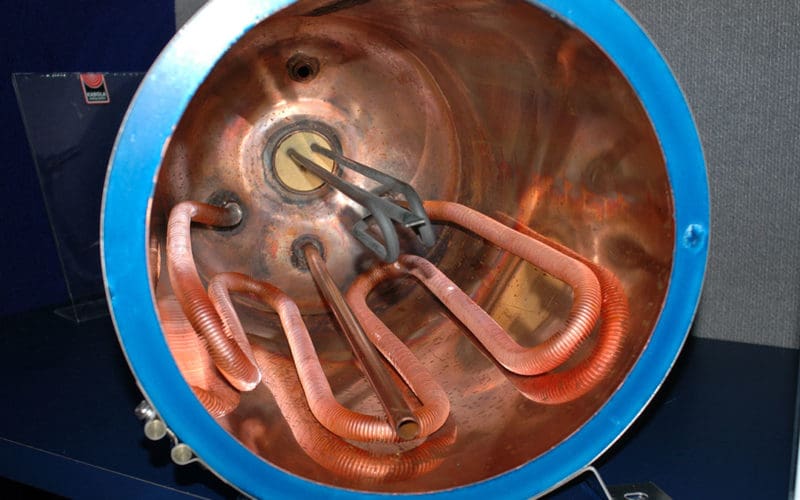
Key facts voyagers need to know about these valuable units
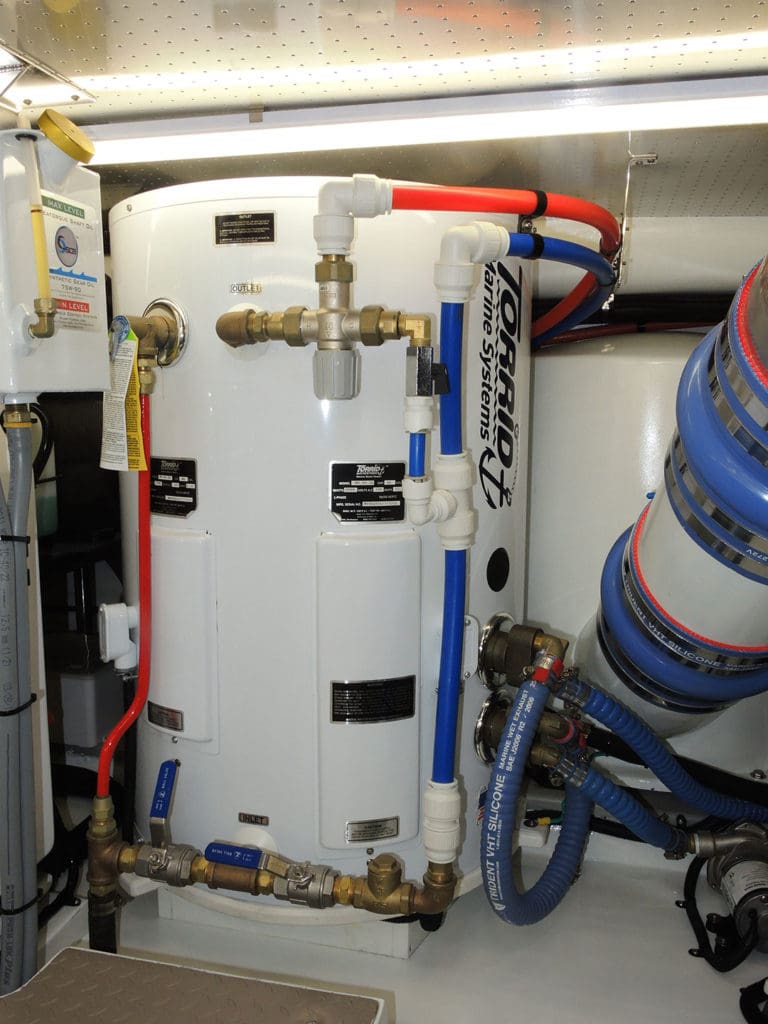
W ith a few exceptions, most electric marine water heaters are simply scaled-down versions of those used in homes and businesses the world over.
The components of these units are relatively simple. An electric heating element is immersed in the water contained within the heater’s tank. It, in turn, is controlled by a thermostat which regulates the temperature of the water. When electricity is applied, the heating element warms the water within until the set point on the thermostat is reached, at which point the heating element turns off.
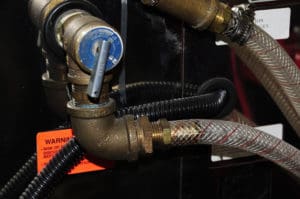
Water heaters also typically include an important safety device, a pressure/temperature relief valve. This is designed to relieve pressure within the water heater’s tank in the event of a malfunction. If, for instance, the thermostat that controls the electric heating element malfunctions, and the water within the heater rises to the boiling point, creating steam and extreme pressure, the pressure relief valve will open and vent the pressure before the condition goes super critical. Of course, if the pressure relief valve is damaged, malfunctioning or capped, then it won’t be able to provide this all-too-necessary safety feature.
Even when a pressure relief valve is working properly it can pose a hazard. Several years ago, while I was managing a boat yard that was responsible for commissioning new vessels, a mechanic was injured by a water heater as he worked alongside it when the pressure relief valve unexpectedly vented, flooding the area with boiling water and steam. Fortunately, his injuries were not severe, however, a subsequent investigation revealed that the thermostat had been improperly wired, essentially bypassing its important control function, rendering the heating element continuously energized. For this reason, the discharge of a water heater’s pressure relief valve should be securely plumbed into the bilge or away from areas that may be occupied at any time. Flimsy hose or tubing simply slipped over the valve’s outlet pipe is inadequate, as it will be blown off by high pressure water and steam. It must be robust and securely clamped in place.
If the vessel is equipped with a direct dockside water pressure system, one which enables a continuous supply of dockside water, the water heater’s pressure/temperature relief valve must be plumbed so that it vents directly overboard. If it’s not installed in this manner, and the valve leaks, the vessel could flood with an unlimited supply of dockside water. Plumbing a pressure/temperature relief valve directly overboard does have one drawback: If the valve leaks, it’s possible it will go unnoticed.
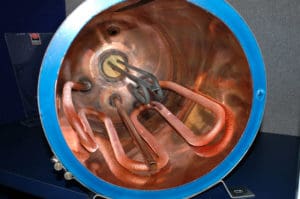
Heat exchangers One feature that marine water heaters, for those so equipped, do not share with those ashore is the heat exchanger. The heat exchanger, much like the one on your engine or generator, simply transfers heat generated elsewhere, in the engine’s closed cooling system or from a diesel-fired hydronic heating system, to the water inside the water heater’s tank. This arrangement is extremely common and has been used effectively for decades. Instead of sending all of the excess heat created by the engine out with the exhaust, some of it is reclaimed for washing dishes, taking showers, etc.
As well as the heat exchanger scenario works, there are a few caveats associated with its use. Utilizing engine coolant to make hot water means the water heater must become part of the engine’s closed or coolant-filled cooling system. While most engine manufacturers make provisions for a water heater connection, when pressed they aren’t keen on the idea because it takes complete control, design and implementation of the cooling system out of their hands; in some cases, they may require another heat exchanger and circulation pump close to the engine.
If the engine’s cooling system fails because of a design or manufacturing flaw, the engine manufacturer is usually responsible for repairs, provided the engine is under warranty. If, however, the plumbing between the engine and the water heater fails, the engine will almost certainly overheat, potentially causing permanent damage, while leaving the vessel powerless.
The engine manufacturer, however, bears no responsibility for a failure of this sort. Therefore, make certain the hose used to connect the engine’s cooling system to the water heater is especially rugged, chafe resistant and robust; hose that carries a J2006R “Marine Wet Exhaust” rating is ideally suited for this role, while ordinary “heater hose,” in spite of its name, may not be up to the task because of its propensity to crush, kink and chafe when routed off the engine and through the vessel.
Additionally, when a water heater is connected to an engine’s closed cooling system certain protocols, as well as the engine manufacturer’s instructions for such an arrangement, must be followed closely. Primary among these is the location or elevation of the water heater, or more specifically its heat exchanger. If the heat exchanger within the water heater, or any portion of the plumbing between the engine and the water heater, is located above the engine’s expansion tank cap, then a remote expansion tank must be plumbed into the system. This tank, with its own pressure cap, then becomes the primary fill point for the closed cooling system, rendering the original legacy fill cap dormant and unusable. In most cases, when a remote expansion tank is installed, it must use a pressure cap that the engine manufacturer calls for while the original cap located on the engine must be replaced with a higher-pressure rating cap. The reason for this cap swap is to ensure that only the highest cap in the system, the one that can vent air, opens and closes with temperature-induced pressure changes, while the cap on the engine’s expansion tank remains sealed at all times.
Hot water temperature Another peculiarity of the marine water heater when it’s interconnected with the engine’s closed cooling system is the temperature of the water it’s capable of producing. The traditional, built-in thermostat controls only the electric heating element, which is typically set somewhere between 120degrees and 140 degrees Fahrenheit. It’s important to note that water heaters are normally set to temperatures above 131 degrees to prevent development of harmful bacteria, such as Legionella, the cause of Legionnaire’s disease, in the water supply. This is of particular concern with marine water heaters because they are turned on and off, which means they often contain stagnant, tepid water, which is an incubator for water-born bacteria.
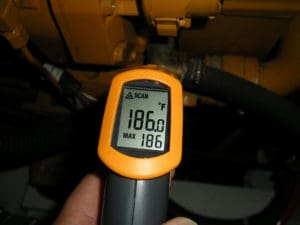
Water at a temperature above 106 degrees is considered painful to some. Personally, I consider 109 degrees the perfect shower temperature, while my wife believes this is much too hot. She prefers something around 105 degrees, (our teenage children didn’t seem to care what the temperature of the water is as long as they used all of it). Anything under about 95 degrees begins to feel chilly. As you can see, there’s not much of a range between comfort and pain or potential injury. At a temperature of 131 degrees Fahrenheit (55 degrees Celsius), a child can be scalded in less than four seconds.
Therefore, it often comes as a surprise to boat owners that the coolant issuing from the engine, and going to the water heater may be as hot as 195 degrees, perhaps 180 degrees by the time it reaches the water heater. Without any external control, water exiting the water heater may be nearly this hot, which clearly presents a serious burn risk. Not long ago, while inspecting a vessel, I opened a galley faucet while underway, only to have a cloud of steam billow forth. It was a sobering experience.
There are two ways this potential safety hazard may be dealt with, both of which offer the same point-of-source approach. The first involves using a mixing or tempering valve. This adjustable device, installed at the water heater, controls the temperature of the water leaving the water heater by mixing it with cold water in order to lower its temperature to the desired level. Therefore, regardless of the temperature of the water in the water heater or the coolant running through the heat exchanger, the output temperature remains constant. The mixing valve has an added benefit, because it enables the water in the water heater to be maintained at a much higher temperature, it effectively provides the user with more hot water for one simple reason: not much of it is needed as it’s mixed with cold water to produce the desired 100 to 110 degrees temperature range.
Adding a mixing valve Mixing valves can be added to virtually any water heater as an aftermarket item, after which the water heater’s thermostat can be increased to maintain a higher electrically-heated pre-product water temperature. It’s important to note that not all mixing valves’ reaction times are quick enough to consider them as anti-scald protection. A variety of standards exist concerning the design and performance of these valves. For more info on this subject it’s worth a visit to www.watts.com/pdf/pg-mxv.pdf. If instantaneous anti-scald protection is desired, then install anti-scald faucets.
The other method utilizes a component known as a temperature compensation valve or TCV, which is plumbed, externally, to the water heater’s coolant heat exchanger while sensing output water temperature. This product takes a slightly different approach in that it controls the amount of coolant running through the water heater in such a way that it maintains a water output temperature of about 140 degrees, which does present a scalding risk.
The beauty of either of these approaches is that they limit the temperature of the water leaving a water heater, regardless of whether the heating source is the electric element or the engine’s coolant. Quick reacting anti-scald valves are, of course, desirable, particularly for showers and sinks; however, it may not be practical or economical to equip every fixture aboard with one of these, particularly after a vessel is built. That’s where mixing valves and TCVs come in. If your water heater is connected to your engine’s cooling system you’re playing with fire unless you install one of these inexpensive devices.
Finally, many water heaters are installed using a check valve on the cold-water supply, which serves two purposes. One, it prevents water from running out of the water heater, potentially damaging the element. Unless it includes protection that prevents it from operating while dry, water heater elements must be submerged while operating. If exposed, their lifespan can be measured in seconds. Two, the check valve minimizes convective heat loss, and comingling of hot and cold water, which also hastens heat loss. If a check valve is installed, the water heater must also be equipped with an expansion tank, which allows water in the water heater to safely expand as it’s being heated. Without this component, the water heaters pressure/temperature relief valve is likely to (hopefully) open, thereby wasting hot water, and defeating the purpose of the check valve. ν
Steve D’Antonio is an ABYC-certified Master Technician and sits on that organization’s Engine and Powertrain, Electrical, and Hull Piping Project Technical Committees. He owns Steve D’Antonio Marine Consulting (stevedmarineconsulting.com) which offers marine systems consulting and pre-purchase services to boat owners, boat builders and others within the marine industry.
- New Sailboats
- Sailboats 21-30ft
- Sailboats 31-35ft
- Sailboats 36-40ft
- Sailboats Over 40ft
- Sailboats Under 21feet
- used_sailboats
- Apps and Computer Programs
- Communications
- Fishfinders
- Handheld Electronics
- Plotters MFDS Rradar
- Wind, Speed & Depth Instruments
- Anchoring Mooring
- Running Rigging
- Sails Canvas
- Standing Rigging
- Diesel Engines
- Off Grid Energy
- Cleaning Waxing
- DIY Projects
- Repair, Tools & Materials
- Spare Parts
- Tools & Gadgets
- Cabin Comfort
- Ventilation
- Footwear Apparel
- Foul Weather Gear
- Mailport & PS Advisor
- Inside Practical Sailor Blog
- Activate My Web Access
- Reset Password
- Customer Service

- Free Newsletter

Ericson 41 Used Boat Review

Mason 33 Used Boat Review

Beneteau 311, Catalina 310 and Hunter 326 Used Boat Comparison


Maine Cat 41 Used Boat Review

Tips From A First “Sail” on the ICW

Tillerpilot Tips and Safety Cautions

Best Crimpers and Strippers for Fixing Marine Electrical Connectors

Thinking Through a Solar Power Installation

Getting the Most Out of Older Sails

How (Not) to Tie Your Boat to a Dock

Stopping Mainsheet Twist

Working with High-Tech Ropes

Fuel Lift Pump: Easy DIY Diesel Fuel System Diagnostic and Repair

Ensuring Safe Shorepower

Sinking? Check Your Stuffing Box

The Rain Catcher’s Guide

Boat Repairs for the Technically Illiterate

Boat Maintenance for the Technically Illiterate: Part 1

Whats the Best Way to Restore Clear Plastic Windows?

Mastering Precision Drilling: How to Use Drill Guides

Giving Bugs the Big Goodbye

Galley Gadgets for the Cruising Sailor

Those Extras you Don’t Need But Love to Have

UV Clothing: Is It Worth the Hype?

Preparing Yourself for Solo Sailing

How to Select Crew for a Passage or Delivery

Preparing A Boat to Sail Solo

On Watch: This 60-Year-Old Hinckley Pilot 35 is Also a Working…

On Watch: America’s Cup

On Watch: All Eyes on Europe Sail Racing

Dear Readers

Chafe Protection for Dock Lines
- Systems & Propulsion
Marine Water Heater Test
Ps reviews water heaters for 30- to 45-foot boats..
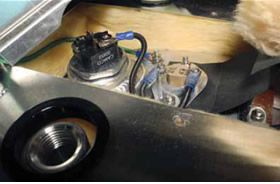
Water heaters are one of those silent heroes that rank high on the list of creature comforts on a cruising boat. Fortunately for us, boat builders long ago moved them from the options list to the standard features tally, and today, they are showing up on smaller and smaller cruising boats.
Ashore, residential water heaters are energy-hungry appliances, but on your boat, theres a convenient, symbiotic relationship between the heater and your diesel auxiliarys need to shed heat. In this case, circulating coolant in the engine is rerouted to the water heater, taking with it excess British thermal units (BTUs) caused by combustion. A heat exchanger inside the water heater then transfers some of this energy to the boats freshwater supply. Cruisers, particularly the stragglers working southward on the Intracoastal Waterway in November and December, appreciate this amicable exchange.
This win-win relationship works best when the right size water heater is chosen and the installation maximizes its reliability. In this in-depth look at water heaters, we focus on how they are made, how they work, and why some cost twice as much as others.
Users and do-it-yourself installers need to know a bit about heat transfer before they twist the tap. Most importantly, you need to be aware just how hot the domestic water supply gets when engine heat is supplied to the built-in heat exchanger. Many diesel cooling systems operate under slight pressure, and that raises the boiling point of the coolant, allowing the liquid to approach 200 degrees without fear of reaching the boiling point. When this heat-laden liquid is plumbed through the heat exchanger in a water heater, the temperature at the domestic water supplys hot faucets can exceed 140 degrees. This is hot enough to cause third-degree burns in only 6 seconds of contact.
If you find your water heater is too efficient when operating in the heat-exchanger mode, and temperatures are too high, you can add a mixer valve that blends cold and hot water as it leaves the water heater. It is important to note that the AC heating element is thermostatically controlled, so you don’t need to rely on a mixer valve when operating on shore power.
In port, its inconvenient and inefficient to run the engine solely to heat up water, and that is why most water-heater manufacturers put a secondary electric heating element in the boiler. These straight resistance devices use 110- or 220-volt AC current to electrically heat water in exactly the same way a household unit operates. Each manufacturer adds a layer of thermal insulation between the boiler tank and the outer shell. The colder the air and water temperature, the more important this insulation becomes. There are also gas-flame (usually propane) water heaters, with some safety concerns of their own, but in this round of testing, we focused on engine heat/AC current units.
What we tested
In our last water heater test ( PS , February 1999 ), Indel Marines all stainless-steel Isotemp 0221R was rated as the Best Choice. This is a well-made water heater, that is efficient and shaped to fit the bilge area aboard a wide range of sailboats. PS tester Frank Lanier has had one working flawlessly on his Union 36 cruising boat for five years now. The other standout in the 1999 test was Heat Transfer Products Marine Water Heater (previously called SuperStor Marine), which earned the Budget Buy. Nearly identical models from both of these manufacturers are still available today, and they retain our stamp of approval. Our testing in this round focused exclusively on new or significantly updated water heaters.
Three of the four test heaters derive heat from either recirculated engine coolant or from shore power when berthed in a marina. A generator could also be used to contribute either hot coolant or AC current to the water-warming process. These units also could be plumbed to a raw-water cooled engine, but be sure to consider the corrosive effects of hot salt water before going this route. Using raw-water circulation will surely shorten the lifespan of a water heater.
The main differences among the water heaters we tested were their construction materials and shape. We intentionally sought smaller 5- or 6-gallon models since these are most commonly found in sailboats from 30 to 45 feet. We added an 11-gallon unit to our testing, but kept it filled to the 6-gallon level when evaluating heat-holding efficiency.
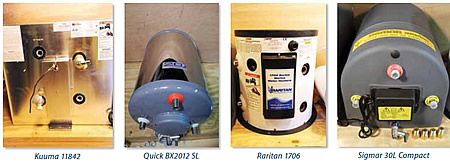
Our test field included two units made in Italy, one from Thailand, and one from New Jersey. Kuuma, a subsidiary of the huge recreational-vehicle parts supplier Camco, sent us its 11-gallon tank. The company also sells a 6- gallon unit with the same 1,500-watt heating element.
Italy-based Quick Nautical Equipment sent testers one of its BX Nautique stainless-steel water heaters. These are efficiently designed, carefully fabricated units that can be mounted horizontally or vertically. Both the Sigmar Marine unit and the Quick water heater come with a handy combination check-valve/pressure-relief valve with a built-in drain lever.
Raritan has been building water heaters for decades, and the company has settled on its own approach to delivering a warm shower. The Raritan 1706 was the only unit we tested this go around that used a high-ferrous content boiler.
Sigmar Marine markets an Italian-made unit that comprises a stainless-steel boiler housed in a robust injection-molded plastic housing. The company uses a two-part, poured polyurethane foam in place of sheet insulation.
Desirable features
There is a lot to measure when it comes to heat-transfer experiments, and it would be easy to go overboard monitoring the extraneous. So, before setting up our evaluation procedure, we identified the desirable features of a good water heater for a cruising sailboat.
Useful attributes:
An ability to rapidly deliver and replenish hot water in both modes of operation.
Enough insulation to keep heated water hot for later usage.
Shaped to fit low in the bilge of a variety of sailboat designs.
Easily mounted, plumbed, and electrically connected.
Quality materials and construction.
Kuuma 11842
Both of the Kuuma units we tested feature a shiny stainless-steel outer shell surrounding an aluminum boiler with an aluminum heat exchanger. We saw no signs of corrosion during our short-term test, but we have some concerns about galvanic corrosion as the copper-based AC heating element, aluminum tank, and stainless-steel sheet metal interact over the long haul.
The manufacturer specifies that units equipped with a heat exchanger should not be used in a raw (salt) water cooling context. A ground fault interrupt (GFI) is recommended.
The box-shaped Kuuma 11-gallon heater used the same heating element as the 6-gallon unit, so by keeping the volume of water in the unit to 6 gallons during part of our testing, we mimicked the heating characteristics of the 6-gallon unit. It came as no surprise that this tank, with its 1,500-watt element, was the quickest to reach 120 degrees. The unit we tested was equipped with a rear-mount heat exchanger, and we found that this approach, plumbing the engine coolant loop away from other plumbing and wiring, could be an asset in certain tight installations.
The alloy heat exchanger was highly heat conductive; testers noted its quick warm-up times. Welded-in-place hose barb stubs on the heat exchanger simplified the plumbing hookups. Testers liked the handy nylon drain valve that lets you drain the tank with very little drama.
Bottom line: The price is certainly attractive, but with warranty exclusions for galvanic corrosion problems, longevity may be an important issue.
Quick Nautique BX2012
Quick uses highly corrosion-resistant 316L stainless steel in the Nautique BX2012s boiler, where it counts, and switches to a polished, grade 304 stainless steel for the outer shell, where corrosion conditions are not so hostile. The cylindrical shape of the unit is well-suited for bilge mounting in sailboats, and the stainless-steel mounting bracket and bands expedite a secure installation.
The small 20-liter (approximately 5 gallons) unit we tested is available with different heating elements (500, 600, and 1,200 watts), which significantly affect the time it takes to heat up cold water. The heating element is a nickel-based alloy (incoloy), and the stainless-steel heat exchanger features a large surface area that delivers good efficiency.
Unlike other heaters, the Quick showed no sign of ferrous metal parts. The Quicks shape makes it easier to mount the water heater as low in the bilge as possible. The directions recommend a double-pole switch on the heater element. It disconnects both the neutral and hot leads, a feature that lessens both shock and stray-current corrosion.
The unit we tested was equipped with the largest heating element offered for this size (1,200 watts), so comparing its thermal rate to that of heaters equipped with smaller elements was like comparing a big genoa with a small jib. Its heat-up speed came in just behind the 11-gallon Kuumas 1,500-watt element. Operating in the heat-exchanger mode, the Quick quickly transferred the engine-derived heat energy to the potable water supply. Because of this efficiency, a mixer valve would prove to be a valuable ally.
We liked the vertical or horizontal mounting options, plus the variable angle of the mounting base. As with the Sigmar unit, theres a need for metric thread adapters.
Bottom line: This compact, relatively easy to install, all stainless-steel water heater is a blend of artfully chosen materials and quality workmanship. It is our Best Choice.

Raritan 1706
Raritans units are made in the U.S. (the only in our test), so finding hose barbs or other plumbing fixtures to fit the National Pipe Thread (NPT) three-quarter-inch pipe thread ports wont be a problem. Because Raritan reduces the size of the plumbing at the ports to approximately a half-inch, the tank has a slower flow-rate than other tanks in the test. A pressure-relief valve is supplied, but a back-flow prevention check valve is not. Raritan provided, as usual, clear installation guidelines.
Raritan was the only test boiler made of high-ferrous-content steel. This SA 180 Grade 70 carbon steel meets American Society of Mechanical Engineers standards for forged carbon-steel pressure vessels, but it is inherently more prone to corrosion than the 316L stainless steel used in other heaters we tested. A hard porcelain enamel is thermally bonded to the inside of the tank, to provide a hard sanitary finish on the inside of the tank and protect against corrosion. According to the companys engineers, glass enameled tanks with anode protection will outlast other tanks in typical boat installation with galvanic and stray current problems.
In our view, an owner should first strive to fix stray current problems on the boat, as these can lead to serious corrosion problems in other systems. So long as the user follows maintenance and installation guidelines, galvanic corrosion is not a major worry on a well-made stainless boiler.
In addition, Raritan says its porcelain-enamel inner coating, plastic exterior cover, and enveloping insulation barrier of high-density, closed-cell foam protect the steel from chloride ions in the salt air. We noted that some portions of the tank are exposed to the air, and the outer insulation is not airtight. Raritan offers a five-year warranty on the boiler as long as the large manganese anode ($90 at West Marine) is checked annually and replaced as needed.
It came as no surprise that the drum-shaped Raritan water heater functioned well in both heat-exchanger mode and when operating under shore power simulation. The wiring, thermostat, overheat protection, and closed cell, high-density foam insulation were well done. There was a rugged feel to the three-quarter-inch NPT recessed plumbing seats, but we found that the half-inch plastic inserts in the hot and cold water inlet and outlet restricted flow.
Bottom line: Raritan has taken measures to build a non-stainless-steel tank that will resist corrosion better than thin-walled, mild-steel tanks that lack anodic protection; and the five-year warranty helps to instill confidence. If buying U.S.-made is a top priority, this tank fits the bill. However, in the absence of long-term test results, we prefer a high-quality stainless steel tank-particularly for saltwater boaters.
Sigmar BC30 UC08
Sigmar Marines compact stainless-steel boiler was clad in a heavy-duty plastic skin. The unit, like Quicks water heaters, is based on a stainless-steel boiler surrounded by poured-foam insulation, but in this case, the outer skin is a tough molded plastic. The 30-liter model (7.9 gallons) also used a 1,200-watt heating element. As might be expected, when the tank was full, it was a little slower to reach 120 degrees than the Quick unit. This was due to the fact that the Quick only had 5.3 gallons of water to heat.
The poured-in foam didnt release any odor when operating in the normal heat range (a possible concern at higher temps). This unit is designed to be installed lying on its side. The built-in heat exchanger, like the boiler, is fabricated from 316L stainless steel.
The male threaded pipe stubs welded to the boiler are metric, not NPT, so thread adapters or metric plumbing fittings are necessary. We also found the stainless-steel pressure-relief valve attached to the threaded stainless cold-water inlet needed some Teflon tape or pipe joint compound in order to stop a minor drip. Stainless-to-stainless threaded joints can gall and require care when tightening. Pipe tape or joint compound are a must. The use of a bronze metric-to-NPT thread adaptor solved the problem.
Plumbing connections and the pressure-relief valve/check valve were very similar to those on the Quick unit, and overall, construction quality was very good.
Bottom line: The efficiency of the Sigmars polyurethane foam surprised us, with over 80-degree water 20 hours after shutting off the heating element. It is Recommended.
All four of these water heaters use a 110- to 120-volt AC heating element when shore power or a good-sized generator happen to be available. Otherwise, they are happy with a supply of BTUs that stream directly from the auxiliary engines cooling system. There are a few plumbing challenges and wiring requirements, but an experienced do-it-yourselfer ready to follow manufacturer wiring and plumbing guidelines should have the skills and tools to install a water heater or replace a unit that has seen more than its fair share of sea miles.
We liked Raritans wiring and its all-NPT plumbing, but we had concerns about the high-ferrous-content steel boiler. Fiberglass and plastic liners did not cover all of the metal surfaces, and the reliance on a large sacrificial anode that can add to annual maintenance seemed a less than optimum marine material approach.
The aluminum boiler of the Kuuma unit we tested proved to be operationally sound, but many boatbuilders shy away from aluminum water tanks because the oxidation powder can foul drinking water, and in some cases, even cause poultice corrosion around welds. There are also some concerns about using bronze or stainless-steel plumbing fittings on an aluminum tank.
We liked the units with stainless-steel boilers and the overall construction quality of the Quick Nautique BX2012 SL and Sigmar Marines BC30 UC08 was very good. In the final tally, the Quick unit nosed out its Recommended Sigmar cousin, but the quality and performance ratings were quite similar. When all was said and done, testers liked the idea of a 316L boiler and found the polyurethane insulation very efficient.
These findings and the questions raised motivated us to plan Phase 2 of water heater testing, with a long-term test aimed at getting a close look at tank metallurgy and the effect it has on water-heater longevity.
- Construction Quality Draws Testers’ Attention

- Installing Water Heaters
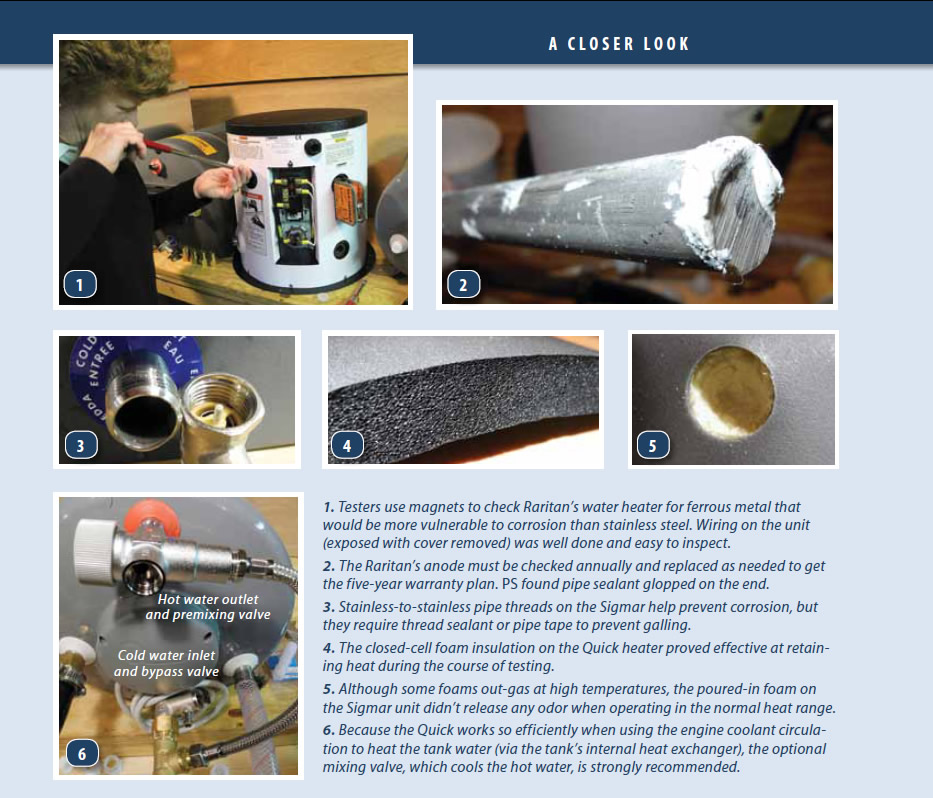
- Mix of Water, Amps, and Heat Calls for Caution
- Heat Transfer Products
RELATED ARTICLES MORE FROM AUTHOR
After reading this review, I know the importance and value of the marine water heater. It’s an investment with a load of benefits. Hot water is a necessity but it can be luxurious when I’m cruising with my boat. It can make a huge difference in my sailing experience due to the immense comfort that it brings.
Hi all, I have the Sigmar 30 liters installed and added the premixing valve. Only problem I have is when I use the shower the first water is boiling hot, only after 20 seconds or so the hot water and cold water mix and only then you can safely use the water. Is there a solution for this? (I have a pressure tank / bladder tank in my watersystem). Regards,……….Eric
LEAVE A REPLY Cancel reply
Log in to leave a comment
Latest Videos

What’s the Best Sailboats for Beginners?

Why Does A Sailboat Keel Fall Off?

The Perfect Family Sailboat! Hunter 27-2 – Boat Review

Pettit EZ-Poxy – How to Paint a Boat
Latest sailboat review.
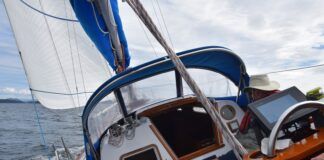
- Privacy Policy
- Do Not Sell My Personal Information
- Online Account Activation
- Privacy Manager
- BOAT OF THE YEAR
- Newsletters
- Sailboat Reviews
- Boating Safety
- Sails and Rigging
- Maintenance
- Sailing Totem
- Sailor & Galley
- Living Aboard
- Destinations
- Gear & Electronics
- Charter Resources
- Ultimate Boat Giveaway

Don’t Land in Hot Water
- By Steve D' Antonio
- Updated: December 2, 2010
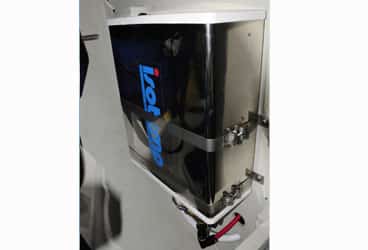
While it may look a lot like the one in your home, the marine water heater is a horse of a different color because many are designed to heat water in multiple ways, with varying results.
Nearly all water heaters will operate using either shore power or a generator. That is, AC current from either of these sources powers a heating element that’s immersed in the water, heating it to a temperature established by a thermostat. It’s important to note that electric water heaters are normally set to temperatures above 131 F to prevent the development of harmful bacteria, such as Legionella, the cause of Legionnaires’ disease, in the water supply. While many folks consider anything above about 105 F to be too hot, remember that hot water, when used, is often mixed with cold, so a higher setting will also mean that your hot water effectively lasts longer.
But most onboard water heaters can also operate by using heat from the engine while the boat is under way. The heat exchanger, much like the one that cools your engine or generator, simply transfers heat that’s generated elsewhere—in this case, in the engine’s closed cooling system—to the water inside the tank of the water heater. Instead of sending all of the excess heat created by the engine out with the exhaust, some of it is reclaimed for washing dishes, taking showers, and similar activities. What’s frequently not well understood by users is the fact that when the water is heated by the running engine, the electric thermostat exerts no control over the temperature of the water. This means that the water within the heater can be heated to the temperature of the engine’s coolant, creating a potentially dangerous scenario.
There’s only one way to control the temperature of water heated in this manner: by installing a tempering valve at the heater or anti-scald valves farther downstream, at the faucets. Tempering valves are easily added to virtually any water heater. The problem, though, is that many of them don’t react quickly enough to a surge of hot water to prevent scalding.
When a water heater is connected to an engine’s closed cooling system, certain protocols, as well as the engine manufacturer’s instructions, must be followed. Primary among these is the one governing the location, with regard to elevation, of the water heater. If the heat exchanger within the water heater or any portion of the plumbing between the engine and the water heater is located above the engine’s expansion-tank cap, then a remote expansion tank must be plumbed into the system. This tank, with its own pressure cap, then becomes the primary fill point for the closed cooling system, rendering the original legacy fill cap dormant and unusable. In most cases, when a remote expansion tank is installed, it must use the pressure cap called for by the engine manufacturer; the original cap located on the engine must then be replaced with a higher-rated cap; check with your engine manufacturer for specific instructions. This will ensure that the cap with the highest elevation in the system, the one that can vent air, is the only one that opens and closes with temperature-induced pressure changes.
Failing to install a remote expansion tank in the above-mentioned scenario could lead to air trapped within the cooling system, which in turn may lead to cold showers or, worse, an overheating engine.
Steve D’Antonio offers services for boat owners and buyers though Steve D’Antonio Marine Consulting .
- More: How To , plumbing , ship's systems , systems
- More How To

Grease the Wheels of Your Boat: A Guide to Proper Lubrication

A Bowsprit Reborn: A DIY Renovation Story

Rigging Redo: Our Switch to Synthetic

Top Tools for Sailboat Cruising: Must-Have Gear for 2024

From Paradise to Medical Emergency: A Bahamas Nightmare Turns Lesson Learned

Free Medical Advice: The Unwarranted, Unprofessional Edition

Gatekeepers of the Waterway

- Digital Edition
- Customer Service
- Privacy Policy
- Terms of Use
- Email Newsletters
- Cruising World
- Sailing World
- Salt Water Sportsman
- Sport Fishing
- Wakeboarding
Visit our Popular Forums
- Monohull Sailboats
- Multihull Sailboats
- Powered Boats
- General Sailing
- Antares Yachts
- Fountaine Pajot
- Lagoon Catamarans
Cruising Business
- Boat Classifieds
- General Classifieds
- Crew Positions
- Commercial Posts
- Vendor Spotlight
Life Aboard a Boat
- Provisioning: Food & Drink
- Families, Kids, & Pets Afloat
- Recreation, Entertainment, & Fun
- Boat Ownership & Making a Living
- Liveaboard's Forum
Seamanship, Navigation & Boat Handling
- Seamanship & Boat Handling
- Training, Licensing, & Certification
- Health, Safety, & Related Gear
- Rules of the Road, Regulations, & Red Tape
Engineering & Systems
- Const. / Maint. / Refit
- Product / Service Reviews
- Electronics: Comms / AV
- Electrical: Batts / Gen / Solar
- Lithium Power Systems
- Engines & Propulsion
- Propellers & Drive Systems
- Plumbing / Fixtures
- Deck Hdw: Rigging / Sails
- Aux. Equipment & Dinghy
- Anchoring & Mooring
Photo Categories
- Member Galleries
- Life Onboard
- Sailing in the Wind
- Power Boats
- Cruising Destinations
- Maint. & Boat Building
- Marine Life
- Scuba Diving & Divers
- General Photos
Recent Photos

Listing Categories
- African Cats
- view more »
- Crew Wanted
- Crew Available
- Enhance Your Account
- Meet the Mods
- Meet the Advisors
- Signup for The Daily Cruiser Email













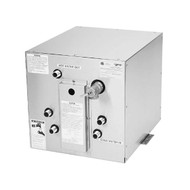



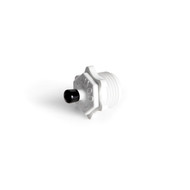










COMMENTS
In most cases, a hydronic system is smaller than a water heater but can also be used as a portable water heater for the boat, especially if you need hot water onboard. It's generally installed in the boat's engine room and can use a coolant to disperse the heat. It can use the fuel coming from the vessel's main fuel tank or a special fuel ...
Hot Water Heater Installation Tips. Secure mounting, corrosion prevention, and smart plumbing are essential. This Indel Isotemp water heater has a pre-mixing valve at the tank. Teflon tape (right) prevents leaks and galling on stainless pipe threads. Although I spent most of my cruising years within 20 degrees of the equator, the landlubber ...
Ideally, it requires an engine of 13hp (a two-cylinder diesel) or greater for a system to produce enough power for hot water without it having too detrimental an effect on the boat's propulsion power. The motor will need to be run for around half an hour to make enough hot water for a shower or two, or an hour or so for all-day hot water.
This sailboat water heater is reliable in delivering hot water. It warms water in just a few minutes so you won't have to wait too long. 2. Kuuma 11G 120V Front Exchanger. Due to this quick marine water heater, the supply of hot water in my boat doubled. It's lightweight with fiberglass sheets for insulation.
The capacity of a marine water heater is an important factor to consider, as it determines the amount of hot water available for use on your boat. Capacities typically range from 6 to 20 gallons, so choosing the right size depends on your boat's requirements and the number of people on board. A smaller capacity may be sufficient for smaller ...
In cold climes, the hot water may be used to heat the boat's engine block, easing starting and reducing the draw on batteries. Espar's Hydronic line of coolant heaters have outputs ranging from 5,500 Btu to 120,000 Btu, which might be adequate to heat the Endeavour. An advantage is that all of the components, excepting external plumbing ...
3027 Capital Blvd Ste 111 , Raleigh NC 27604-3399. home. categories. plumbing & ventilation. marine plumbing. freshwater systems. water heaters. Bring the comforts of home on board with a marine water heater. Having on-demand hot water to wash dishes in the galley, take a shower or warm up wetsuits is a huge step up in making your time on board ...
Any boat that uses its engine fairly regularly produces hot water as a by-product of the combustion process, and it's free. Once you've shelled out for the equipment that is - which in this case is a boat water heater known as a marine calorifier. This device is effectively an insulated heat exchanger, which plumbed into the engine cooling ...
Jan 28, 2010. When replacing the pressure water system on our project boat, we thought it would be fun to install a water heater. But where to put it? Like most early '70s boats, our Norlin 34 lacks interior volume compared to modern boats. The need for the heater to be mounted below the engine's heat exchanger (to prevent problems with ...
A hydronic system is typically smaller than a water heater, but it can also be used as a portable water heater for the boat, especially if you need hot water. It's usually found in the engine room of a boat and can disperse heat with the help of a coolant. It can run on either the vessel's main fuel tank or a separate fuel tank.
These are the parts you will need in order to retrofit a marine hot water system to your boat. Estimated equipment prices. Calorifier - from £350. Immersion heater element - from £68. Water pump - from £49. Expansion tank - from £62. Food quality hot water hose - £2.78/m. Sink basin and shower mixer tap - from £94.
This video shows the upgrade of my central boat heating in my 35ft sailboat. Now I can get hot tap water on demand without using the engine and have an exten...
Therefore, it often comes as a surprise to boat owners that the coolant issuing from the engine, and going to the water heater may be as hot as 195 degrees, perhaps 180 degrees by the time it reaches the water heater. Without any external control, water exiting the water heater may be nearly this hot, which clearly presents a serious burn risk.
An ability to rapidly deliver and replenish hot water in both modes of operation. Enough insulation to keep heated water hot for later usage. Shaped to fit low in the bilge of a variety of sailboat designs. Easily mounted, plumbed, and electrically connected. Quality materials and construction.
Because the water heater on your boat has two sources of heat, you need to understand the differences in temperature that are possible to avoid a scalding. "Hands-On Sailor" from our December 2010 issue. If you install or replace a water heater, use high-quality hose to avoid any chance it could rupture. SAE J2006-rated hose works well.
Shouldn't be too big of a problem. My wife takes 10-15 minute showers on our boat. If you have a 10-12 gallon water heater or two 6 gallon water heaters like we have on our catamaran, we just turn up the thermostat on the water heaters to 160-180.( If you run the engines for any length of time the water will be that hot anyway) This enables her to mix a very small amount of superheated water ...
Boat Water Heaters at Fisheries Supply Marine water heaters are important components for any boat, providing hot water for showers, dishwashing, and other onboard needs. Fisheries Supply, a leading provider of marine equipment, offers a wide selection of boat water heaters and related parts. We carry leading brands like Torrid, Isotherm, or Whale.
12V WATER HEATER. Part no: S360EW. Hot water on-the-go for outboard boats. No generator / inverter / shore power required. Rapid heat up provides hot water in less than 1 hour*. Ideal for use with deck showers - perfect for warming wetsuits. Safety features include low current switching, integrated temperature and pressure valve, thermal cut ...
Apr 10, 2006. #6. Really hot water. In the summer the engine make the hot water as hot as you can stand it. Of course it is only converting from 70 deg. to scolding temp. In winter it takes a good bit more of motoring but it works! In the winter, at the dock the elect hot water tanks works fine, it just takes time.
Let us help. 206-632-4462. Email. A hydronic heating system, similar to home heating systems, uses a hydronic heater to circulate hot water through pipes to radiant heating rafts or fan units.
Water is carried through -, -, or one-inch pipe, depending on the unit size, and to make it even easier to move hot water throughout a boat. Now if only you could have more privacy. (877) 417-8339. This article originally appeared in the November 2011 issue of Power & Motoryacht magazine. If you're on an extended cruise, you can never have ...
1. Whale Water Heater - Premium. The Whale Water Heater 120V is the ideal boat hot water heater. It efficiently maintains an ample supply of hot water of up to 11 gallons. With its double-walled heat exchanger system, the whale water heater utilizes the closed cooling system to heat water as the boat is running.
Marine Water Heaters. When you need hot water while enjoying your boat, you can find a dependable marine water heater from Wholesale Marine. We stock a variety of heaters and replacement parts for leading manufacturers including Camco, Kuuma, and Raritan Engineering.Marine water heater capacities range from 3-gallons to 15.8-gallon tanks and are perfect for supplying hot water for showers ...